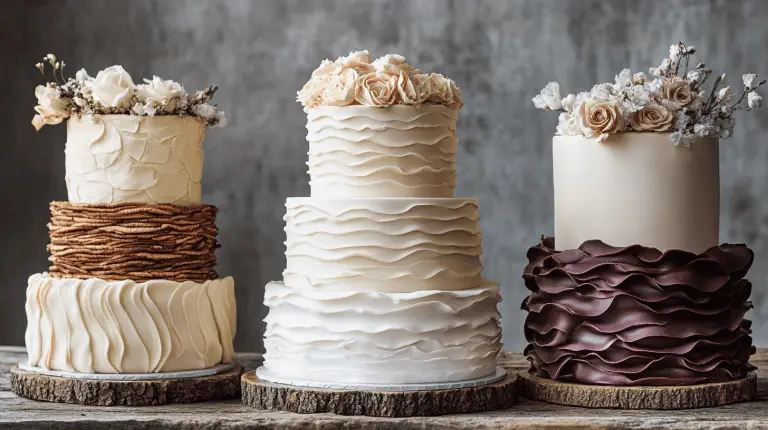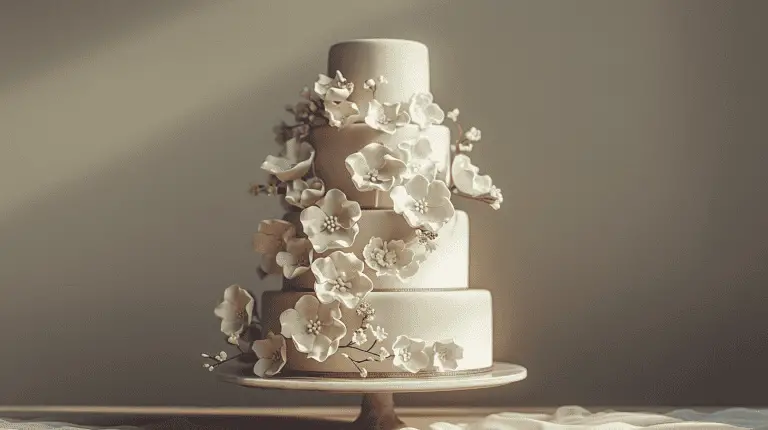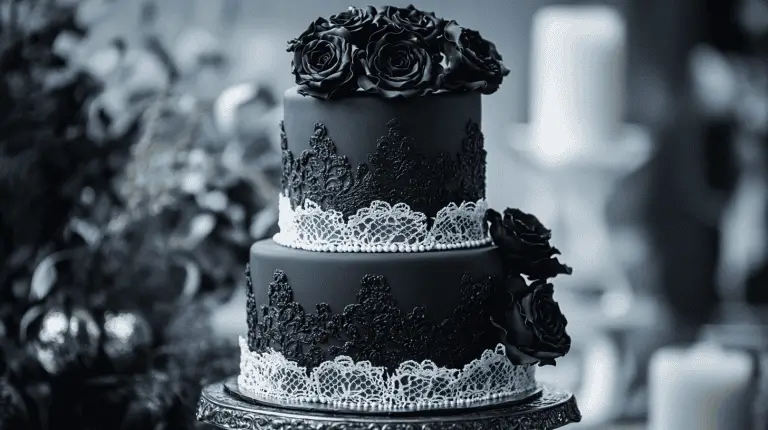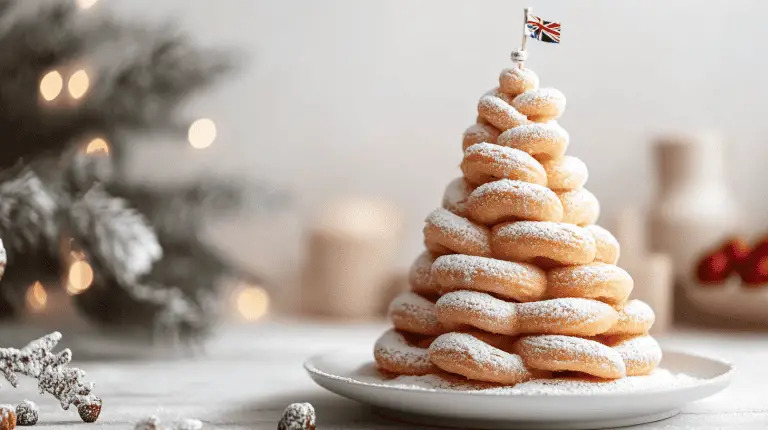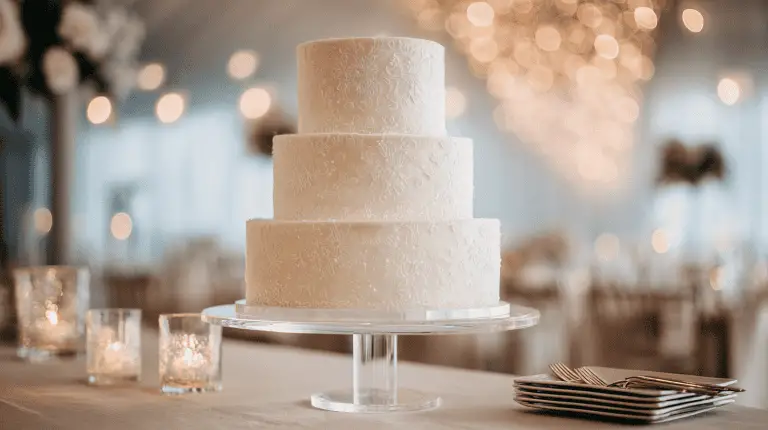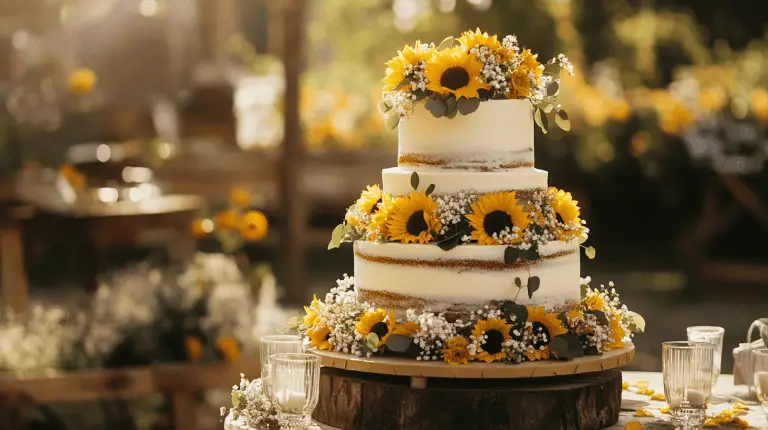Best Victorian Wedding Cake Ideas: Timeless Elegance and Charm
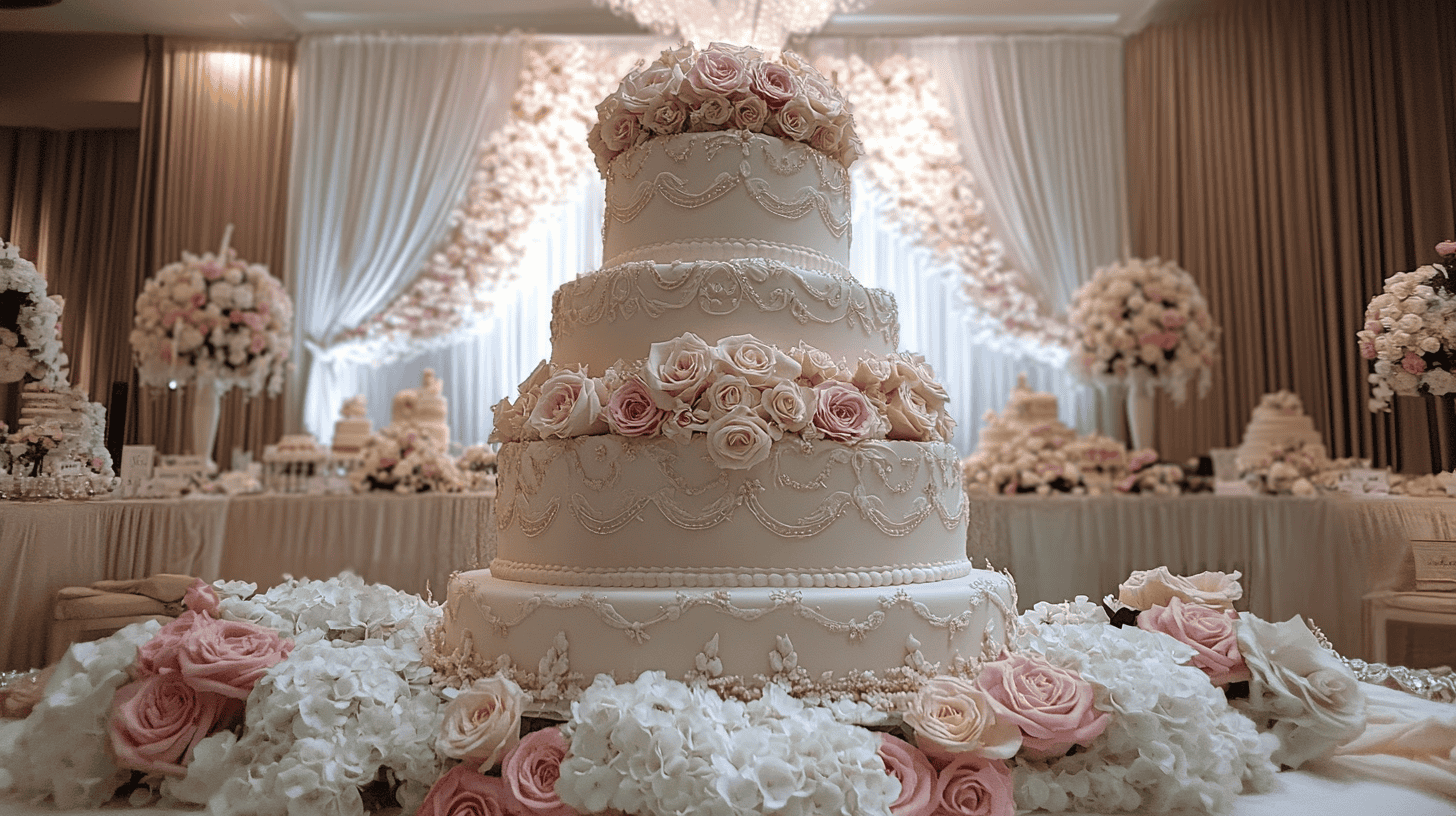
A Victorian-inspired wedding cake brings the charm and elegance of a bygone era to modern celebrations, featuring intricate designs and delicate decorations. These cakes, often marked by their multi-tiered structure and charmingly detailed embellishments, can serve as a centerpiece at any vintage-themed wedding. Victorian wedding cakes are renowned for their unique aesthetic that combines sophistication with a touch of whimsy.
Utilizing rich flavors and ornate decorations, these cakes often incorporate elements like lace patterns, sugar flowers, and elaborate piping. The choice of colors such as ivory, pastel, and gold enhances the vintage feel, appealing to those who seek elegance and grace. Brides and grooms often find that incorporating Victorian motifs into their wedding cake offers a timeless nod to tradition while still keeping the affair stylish.
Evolution of Victorian Wedding Cakes
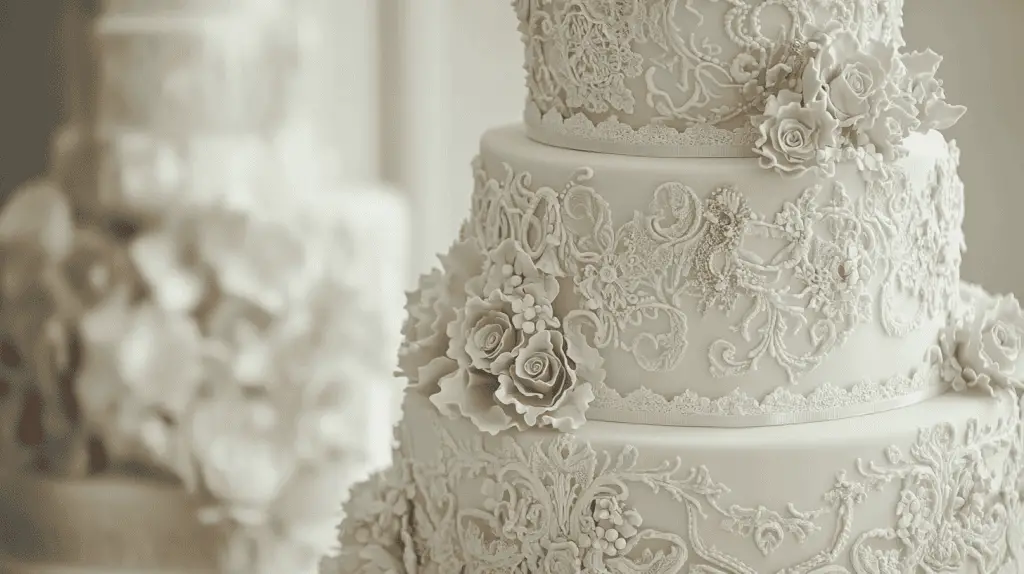
Victorian wedding cakes have undergone significant transformation influenced by historical trends and fashion styles. Their rich history enhances their charm and relevance even in today’s celebrations.
Historical Significance of Vintage Cakes
The evolution of Victorian wedding cakes began during the 19th century, a period marked by opulence and grandeur. These cakes, inspired by Queen Victoria’s wedding to Prince Albert, established traditions that are still revered.
Originally, cakes were plain, consisting mainly of fruits and nuts, covered with a simple icing. Over time, they became elaborate creations showcasing intricate decorations and tall tiers. Marzipan and fondant became popular for their smooth texture, allowing for detailed designs that mirrored the architectural elegance of the era.
The trend of multi-tiered cakes originated from this period, symbolizing wealth and class. Elaborate sugar work and lace details were often used to match the bride’s gown, emphasizing unity between the cake design and the bridal fashion of the time. The wedding cake evolved from a mere dessert to a centerpiece displaying social status and artistic flair.
Influence of Fashion on Cake Design
Fashion played a crucial role in the aesthetic development of Victorian wedding cakes. The intricate patterns and lace used in bridal gowns directly influenced cake decorations. Cake artists drew inspiration from high fashion trends, incorporating patterns and colors reflective of popular styles.
The use of pastel colors and floral motifs on cakes mirrored the soft hues and nature-inspired details found in dresses of the era. As fashion became bolder with the introduction of new fabrics and silhouettes, cakes mirrored these changes by incorporating bolder colors and more elaborate designs.
Vintage wedding cake ideas often draw from these elements, offering a timeless elegance and sophistication. Even in modern weddings, vintage-inspired cakes encapsulate the romance of the Victorian era, blending historical charm with contemporary tastes. Brides and grooms today often choose these designs to echo the grandeur of the Victorian past with a modern twist.
Key Elements in a Victorian Wedding Cake
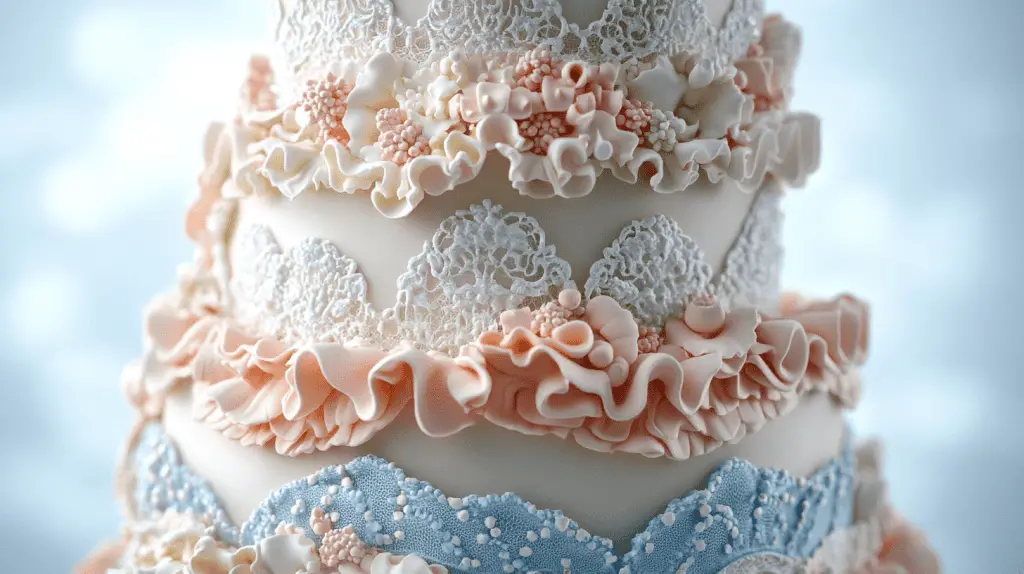
Victorian wedding cakes are defined by their ornate details, soft hues, and elegant textures. They often incorporate lace-inspired embellishments, delicate ruffles, and pastel shades, creating an air of romance and sophistication.
Lace Patterns and Details
Lace designs on Victorian wedding cakes capture elegance and attention to detail. These patterns often mimic the intricate lace one might find on a wedding gown, featuring floral motifs and delicate webs.
Edible lace adds texture and visual interest to the cake’s surface, sometimes extending across tiers for a cascading effect. It’s common to see these details crafted from fondant or royal icing, adding a touch of vintage charm to modern-day cake artistry.
Ruffles and Textures
Cake decorators often employ ruffles to create a luxurious and rich texture on Victorian wedding cakes. These ruffles mimic fabric layers and can be placed in tiers or flow continuously down the cake’s side.
The ruffles use fondant or buttercream to add a tactile element that draws the eye. This element provides a soft, romantic texture, contributing to the cake’s lavish and traditional appearance.
Soft Pastel Color Palette
A Victorian wedding cake typically features a soft pastel color palette, which imparts a sense of gentle elegance and tranquility. Soft hues like blush pinks, mint greens, and lavender often dominate.
These colors harmonize well with floral decorations and other embellishments, allowing the cake to fit seamlessly into the wider wedding theme. The palette reflects the subtlety and sophistication synonymous with Victorian aesthetics.
Intricate Polka Dots and Ribbons
Incorporating polka dots may seem whimsical, yet in the Victorian style, they are used intricately and thoughtfully. These small dots, often made from sugar or fondant, can line the cake, providing a subtle contrast in texture or color.
Burlap ribbons and similar embellishments often accompany polka dot patterns, tying into the cake’s overall design. They encircle tiers or drape elegantly, adding layers of depth and style to the centerpiece.
Innovative Victorian Cake Designs
Victorian wedding cake designs continue to captivate with their fusion of classic and unique elements. This section explores the use of fresh flowers for a natural touch, satin and silver accents for elegance, a rustic twist on traditional designs, and art deco inspirations.
1. Role of Fresh Flowers in Vintage Cakes





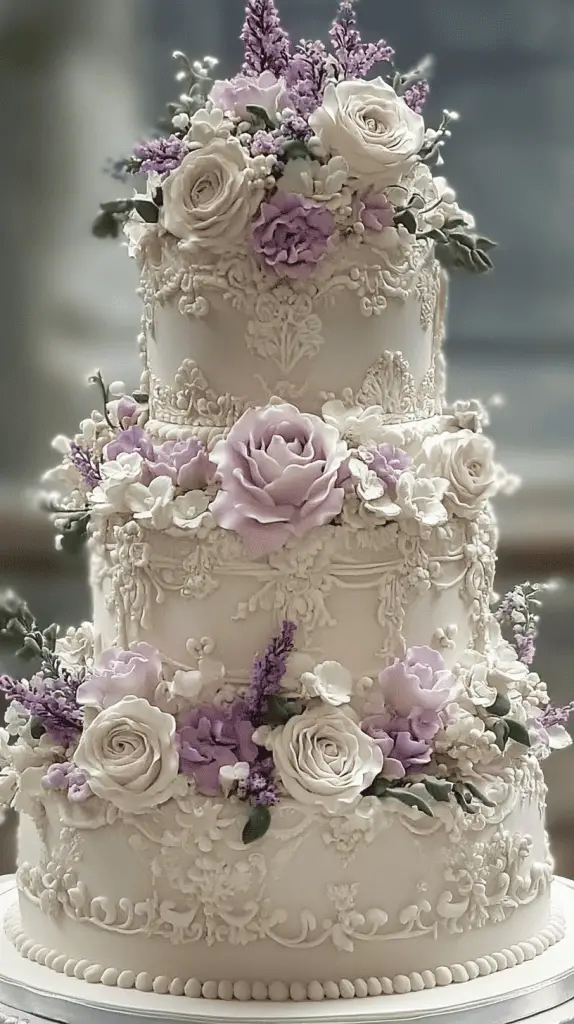
Fresh flowers remain a timeless choice for Victorian wedding cakes. Roses, peonies, and violets often adorn these cakes, adding natural beauty and fragrance. They are carefully selected to match the wedding theme and color palette. Florists and bakers work together to ensure the flowers complement the cake’s flavors and design.
Using fresh flowers not only enhances the visual appeal but also aligns with sustainable and natural trends. The selection often includes edible blooms, offering a dual purpose of decoration and unique flavor elements like lavender or rose petals. This approach requires attention to detail, ensuring all flowers are safely used and do not overpower the cake’s taste.
2. Elegance of Satin and Silver Accents
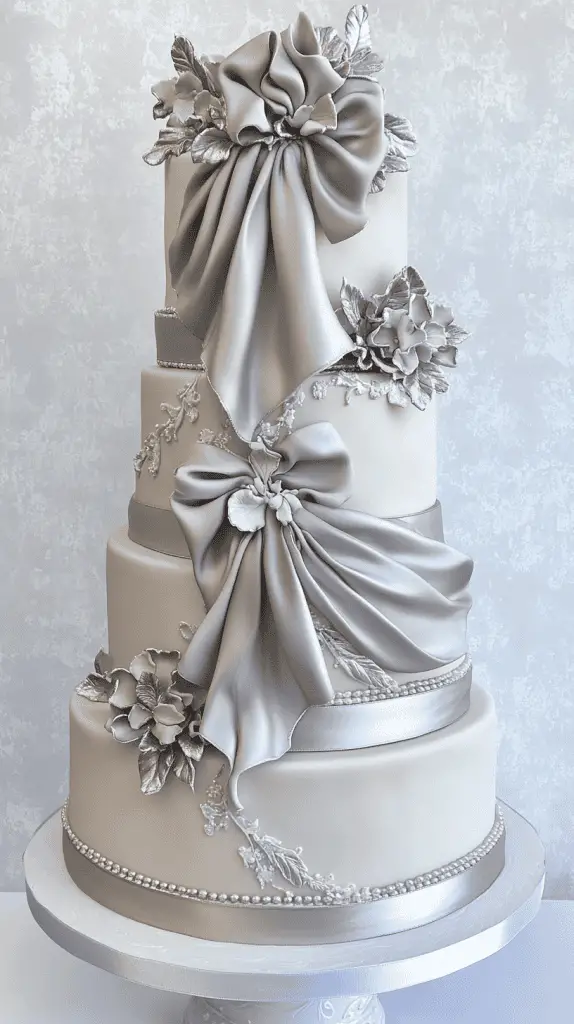
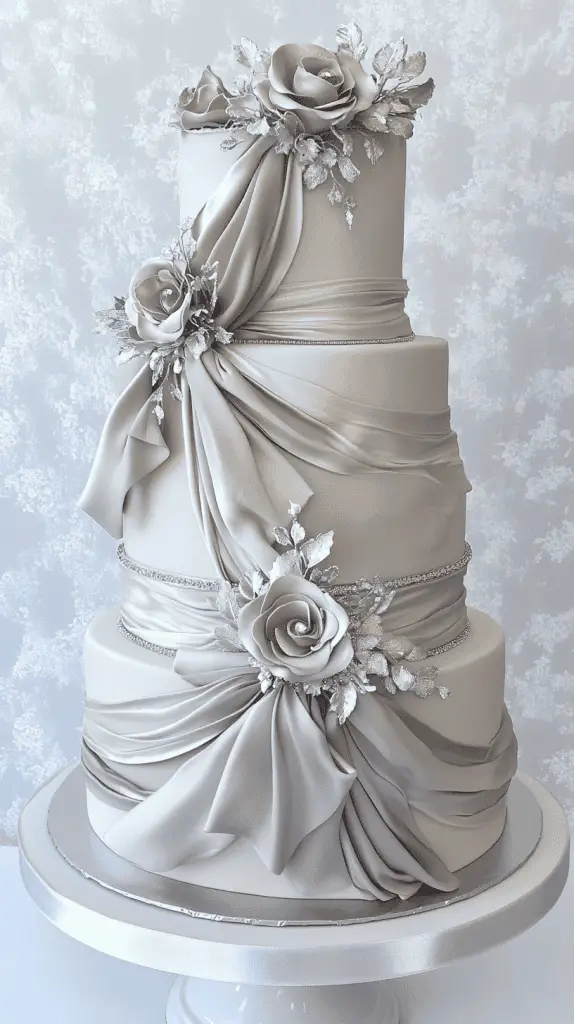
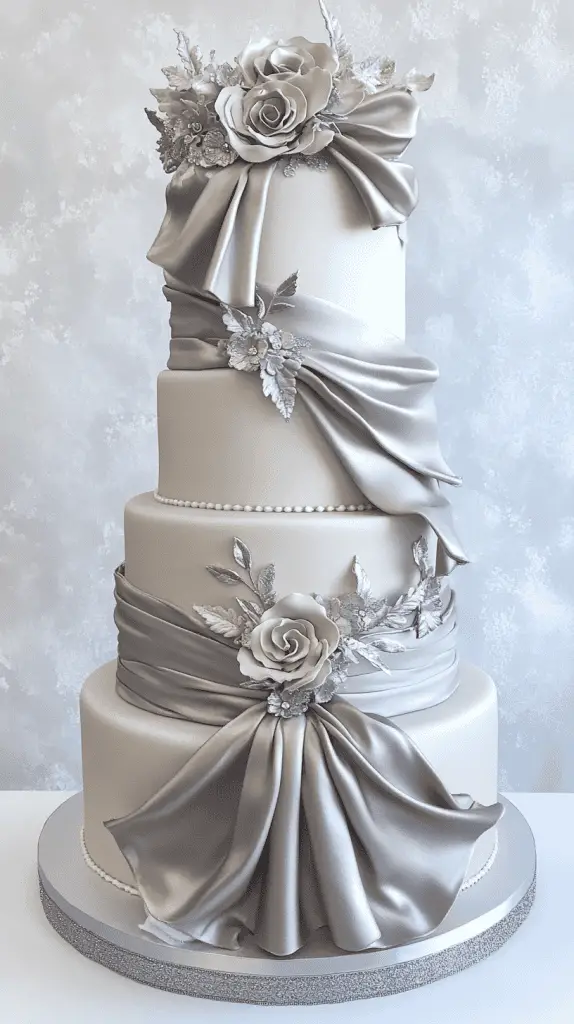
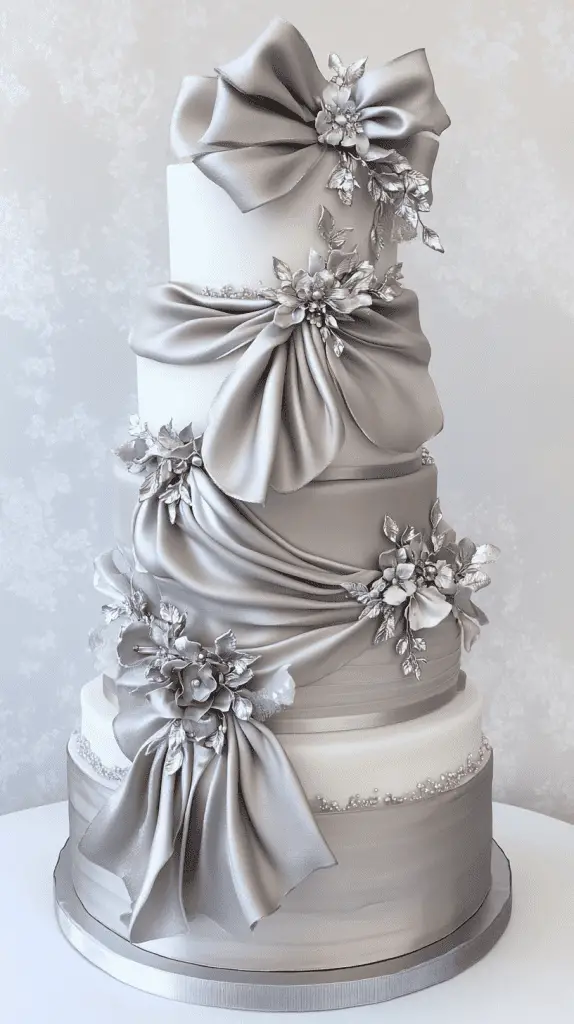
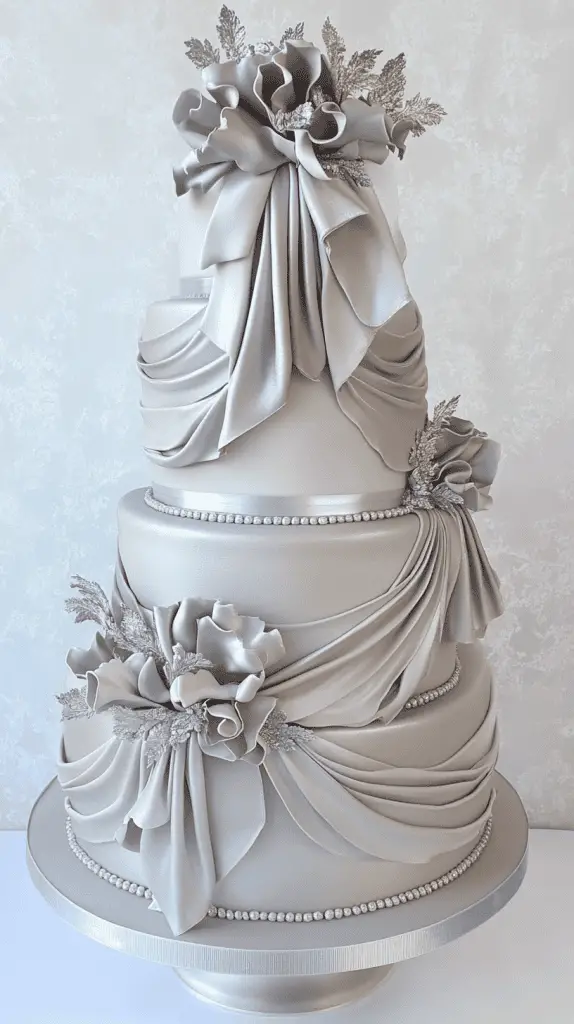
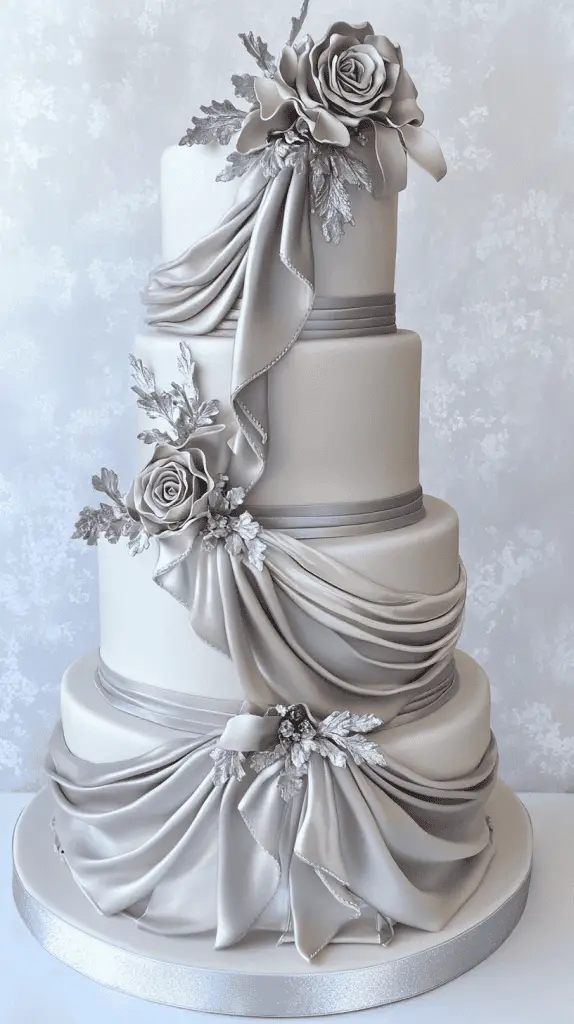
Satin and silver accents elevate the sophistication of Victorian wedding cakes. Satin ribbons wrap around tiers, adding softness and contrast against intricate frosting details. These elements often include a satin bow or cascading satin ribbons, enhancing the visual interest and offering a tactile quality.
Silver graces the cakes with its reflective quality, often appearing in delicate piping or metallic leaf adornments. Cakes may feature silver-dusted elements or entirely silvered tiers, catching light beautifully. These accents lend a regal air, perfect for opulent celebrations. Balancing these metallic touches with softer elements ensures they highlight rather than overwhelm the design.
3. Rustic Wedding Cakes with a Victorian Twist





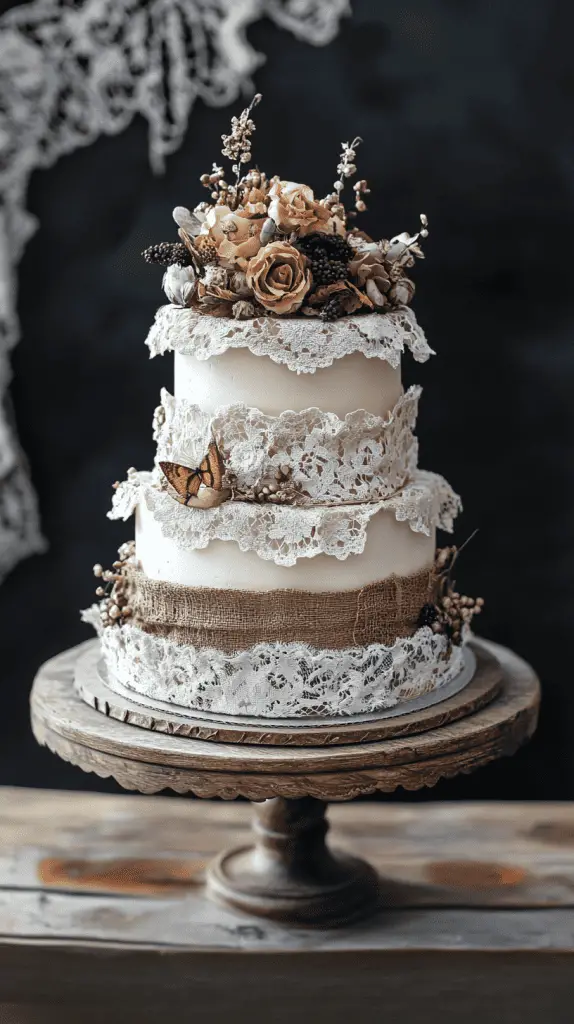
Combining rustic aesthetics with Victorian design principles offers a unique cake experience. Rustic wedding cakes may feature natural icing textures, exposed layers, and earthy tones while incorporating classic Victorian embellishments like lace patterns or floral motifs. This blend creates a harmonious design that suits both traditional and countryside settings.
Utilizing wood-inspired cake stands or incorporating seasonal fruits and nuts adds a heritage feel. Cakes can also include simple yet elegant elements like burlap ribbons paired with intricate piping, reflecting a blend of rural charm and Victorian sophistication. This style supports a relaxed yet refined atmosphere, perfect for couples who appreciate both natural and historic beauty.
4. Art Deco Inspiration in Wedding Cakes





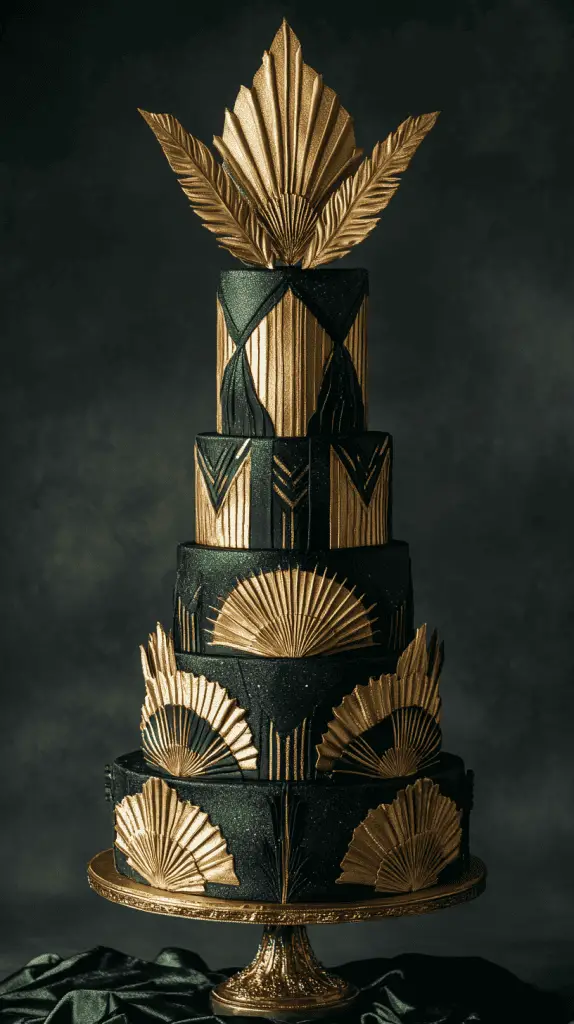
Art deco styles bring a modern twist to Victorian wedding cakes, infusing geometric precision and bold lines with traditional elegance. These cakes often showcase stylized motifs, intricate patterns, and metallic hues, reflecting the grandeur of classic art deco design combined with Victorian elegance.
Designs may feature tiered cakes adorned with art deco patterns, incorporating elements like feathers, fans, and sunbursts. These details highlight the cake’s structure and elegance. Bold color choices, such as deep greens, blacks, and golds, distinguish these cakes. Adding sleek geometric shapes or tiers reinforces a clean and sophisticated silhouette, making it ideal for couples seeking a dramatic and stylish celebration.
5. Ornate Lacework: Timeless Elegance in Sugar
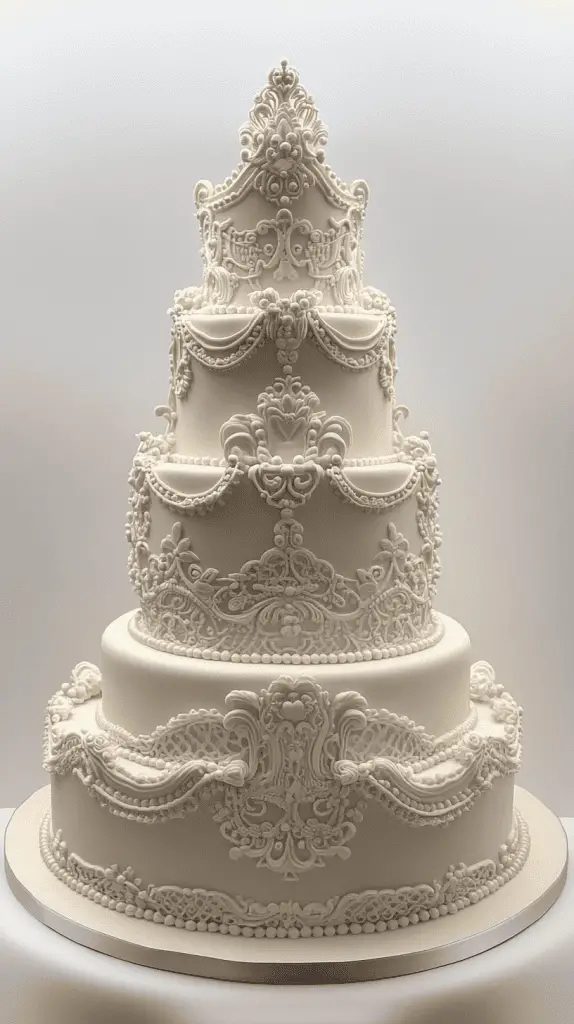
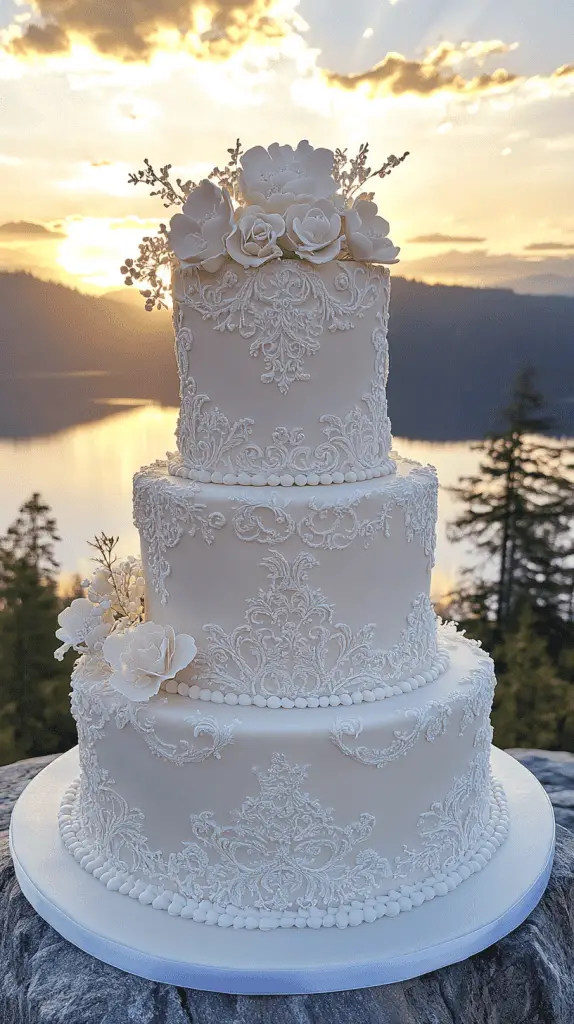
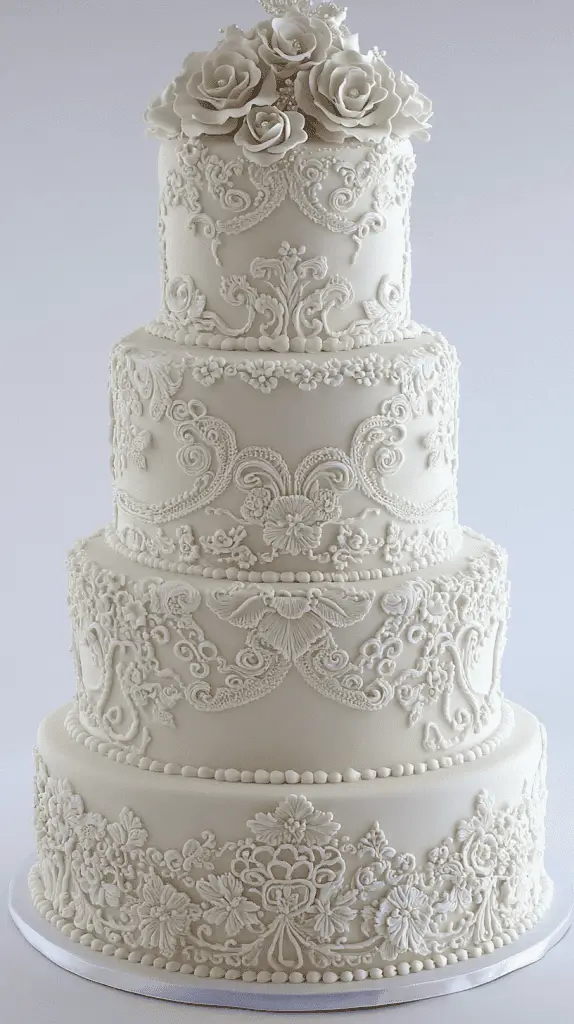
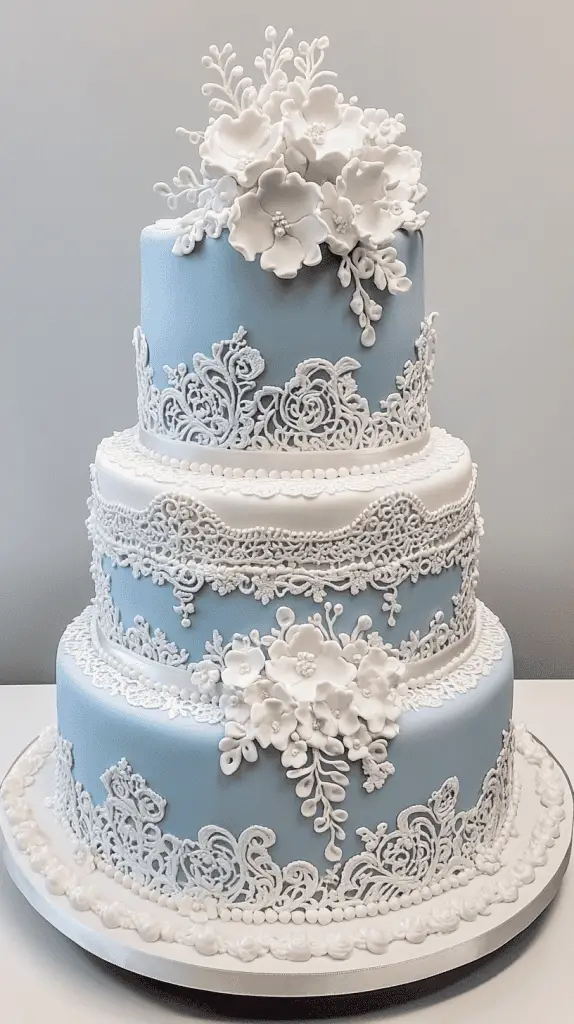
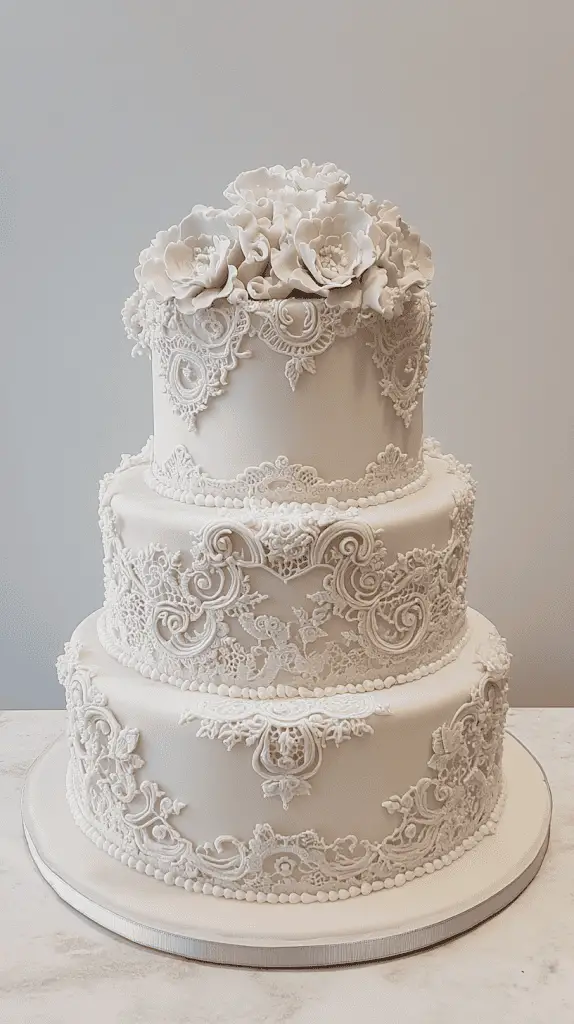
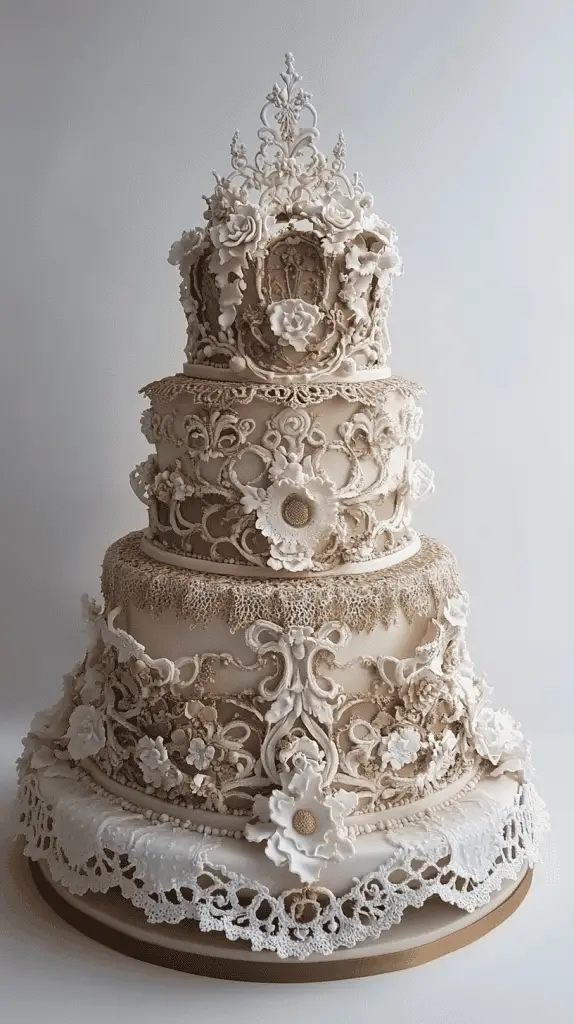
Ornate lacework on wedding cakes captures the essence of Victorian charm and sophistication. These intricate sugar designs reflect the elegance of lace fabric, bringing a touch of timeless beauty to any celebration.
Lacework involves delicate piping techniques that require skill and precision. Bakers create floral patterns, scrolls, and even elaborate doilies using royal icing or fondant.
A popular choice for Victorian-themed cakes, this technique often incorporates elements like pearls and intricate borders to enhance visual appeal.
When selecting a cake with lacework, couples might consider different color palettes. Classic white on white is perfect for a traditional look, while subtle pastel shades can add a modern twist without losing the Victorian charm.
Some bakers include gold or silver accents to provide a touch of luxury and make the lacework stand out even more.
To highlight the ornate details, couples may opt for a tiered cake design. The height adds a dramatic effect, allowing the lace patterns to cascade elegantly down the sides. A lace-inspired cake topper or fresh flowers can complement the design further.
Incorporating lacework into a wedding cake not only honors the Victorian era’s love for decorative elements but also showcases the skill of the baker, making it a stunning centerpiece for any wedding.
6. Pillared Masterpieces: Regal Heights of Victorian Tradition
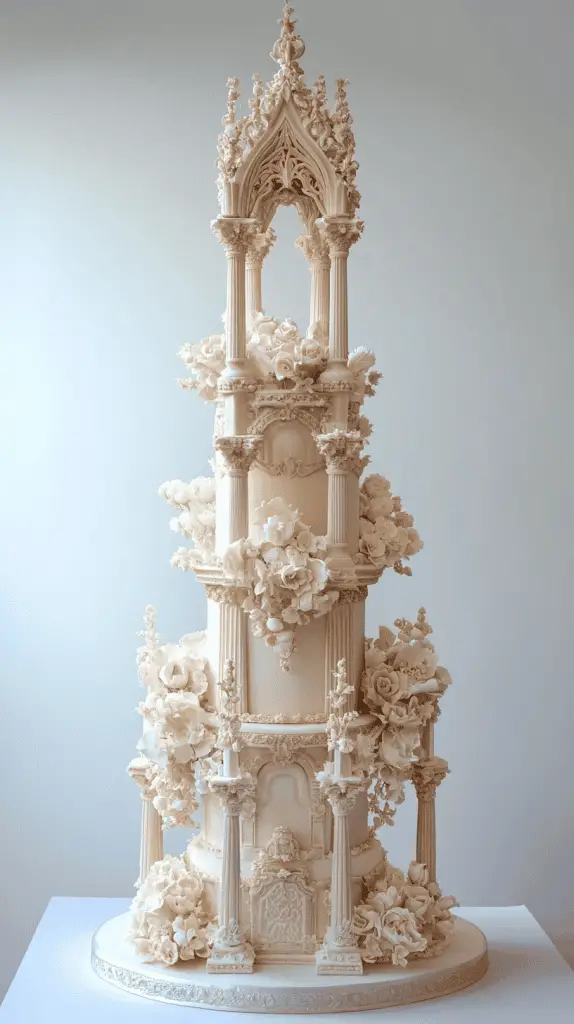
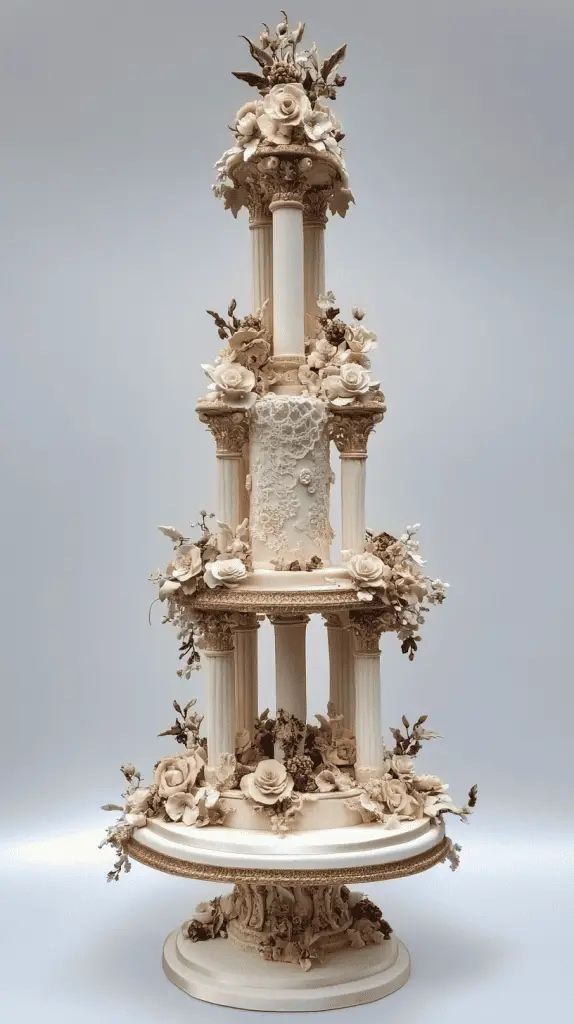
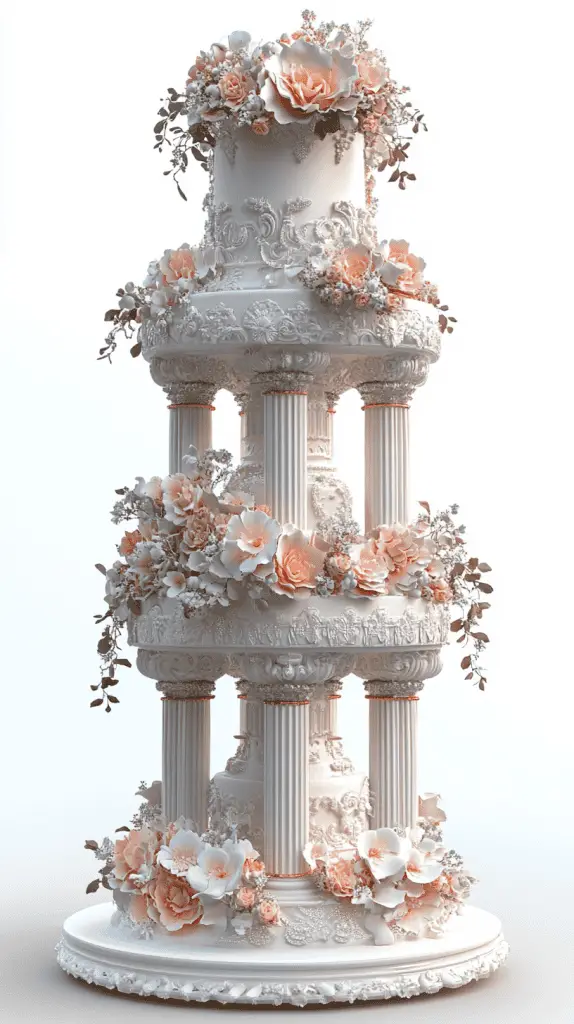
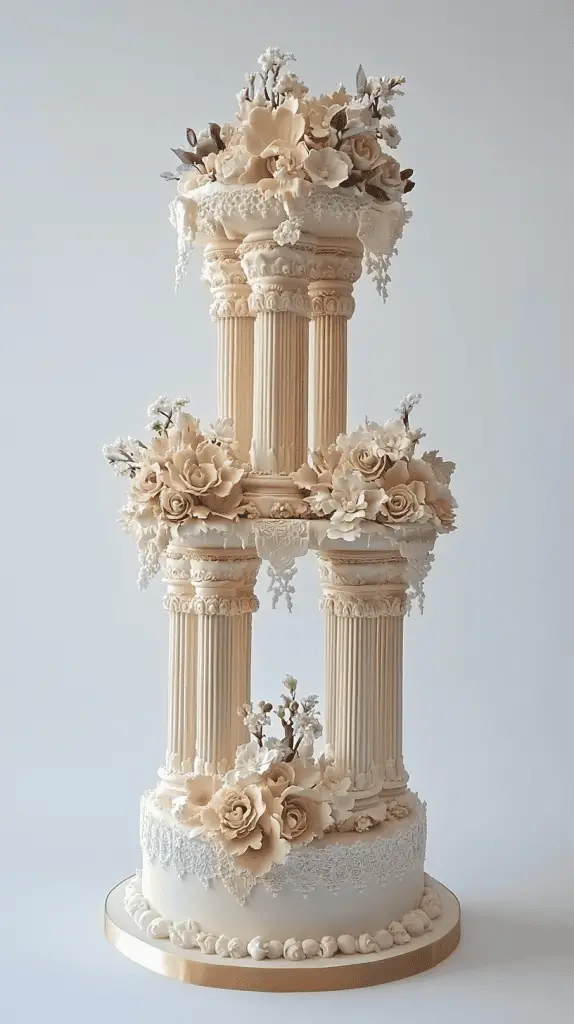
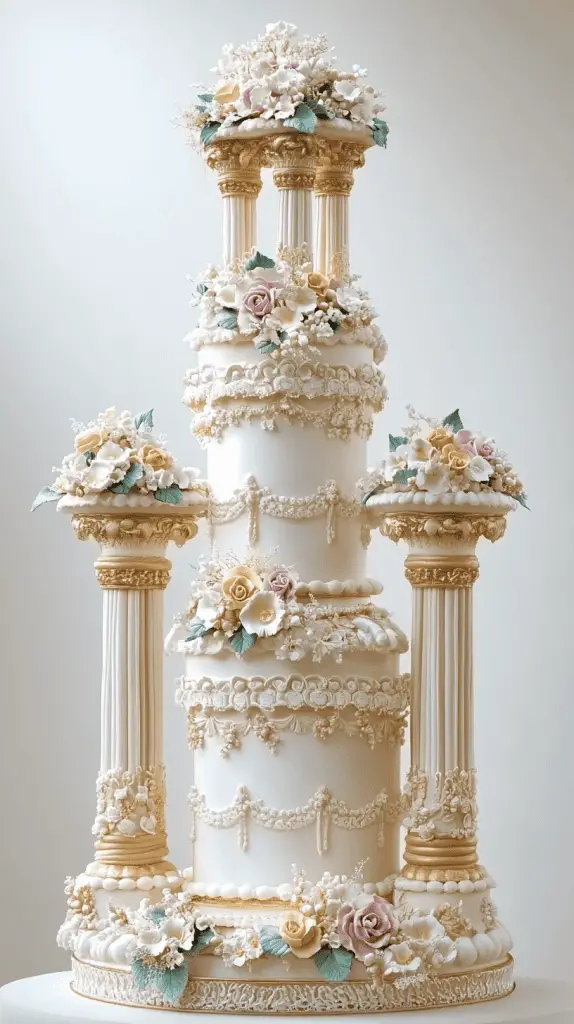
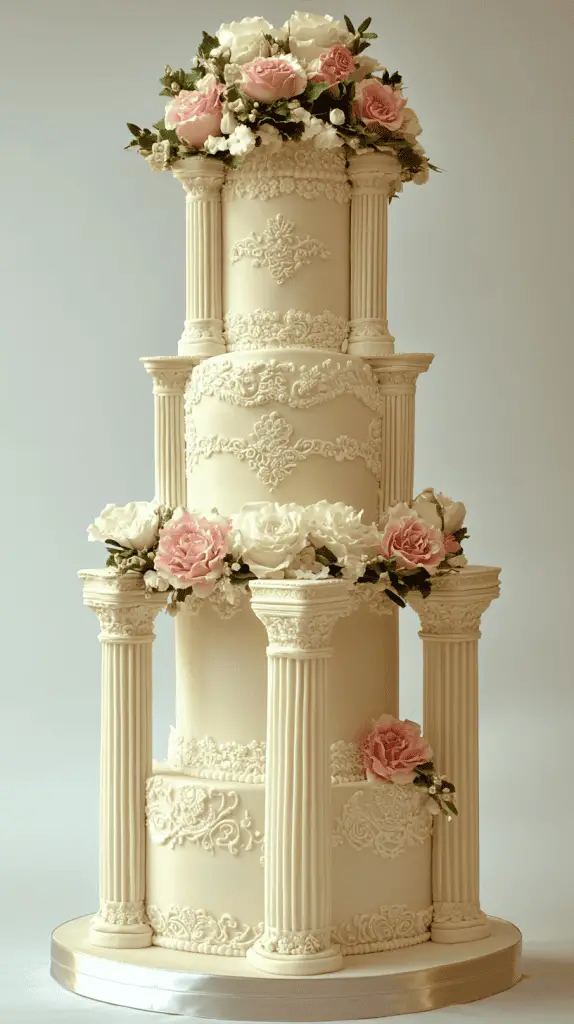
Victorian wedding cakes often featured pillared tiers that created an air of opulence and grandeur. These designs brought wedding celebrations to new heights, both literally and figuratively.
Typically, these structures included ornate columns supporting multiple layers. Each tier gracefully presented its own design, adding charm and sophistication.
Popular features of pillared cakes:
- Decorative Columns: Crafted from sugar or wood, these columns added elegance.
- Varied Heights: Towers of cake layers introduced an eye-catching silhouette.
A Victorian cake might display layers covered with delicate lace patterns and vibrant floral arrangements. Such intricate designs were a hallmark of this era. Adding fresh or sugared flowers between tiers enhanced their natural beauty.
Pillared cakes often served practical purposes, enabling larger guest lists. Sections allowed for different flavors, catering to various tastes within the audience.
For those seeking Victorian authenticity, reproducing these cakes involves a balance between beauty and architectural skill. Bakers often employed advanced techniques to ensure both stability and visual appeal.
Images of these cakes might include elements like gold leaf accents or pastel-colored icing. With careful attention to detail, each cake becomes a bespoke piece of culinary art.
Victorian-era wedding cakes remain a timeless inspiration, capturing the splendor and refinement of the past. Their grand heights continue to symbolize celebration and unity.
7. Pastel Romance: Soft Hues of a Bygone Era
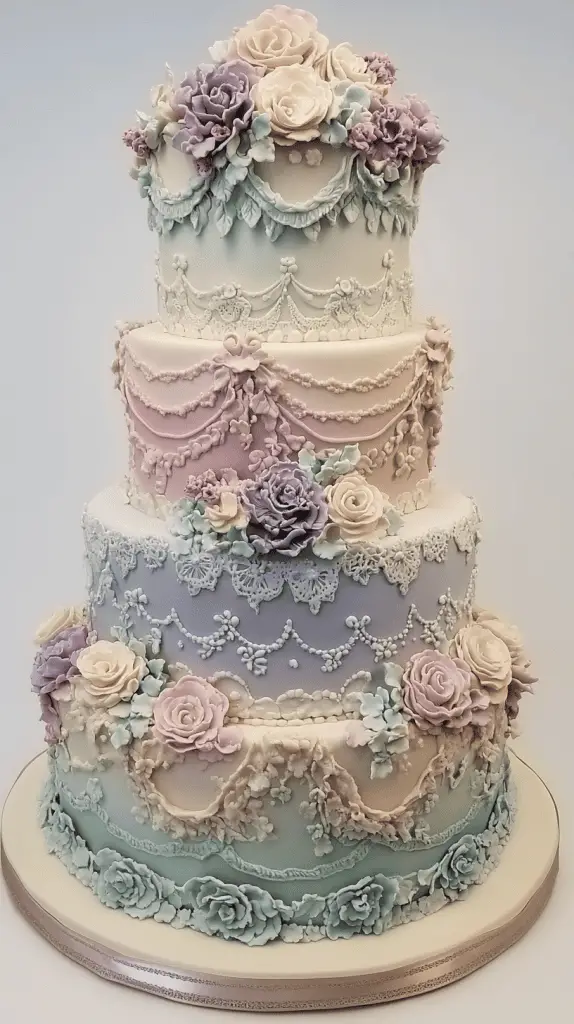
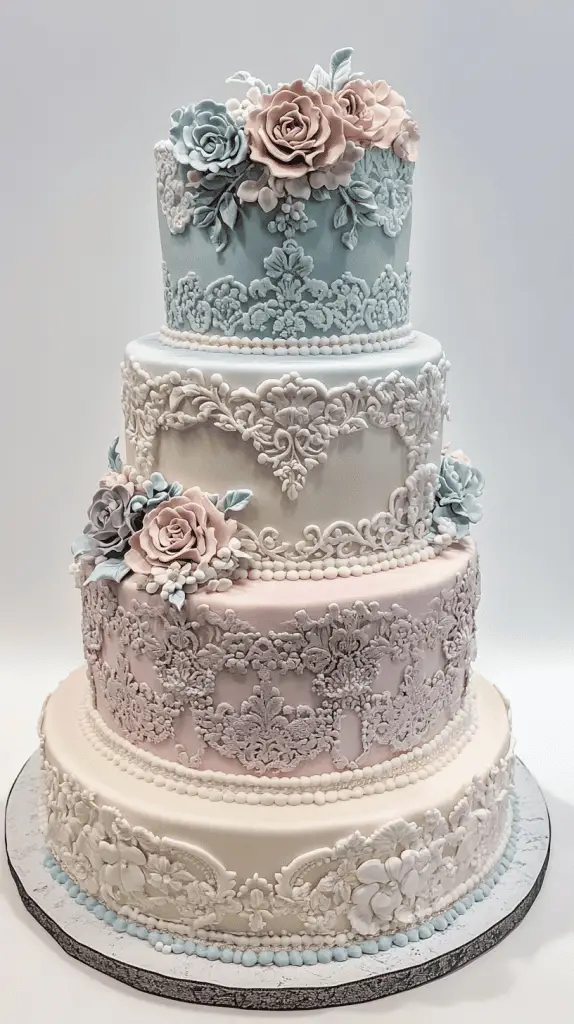
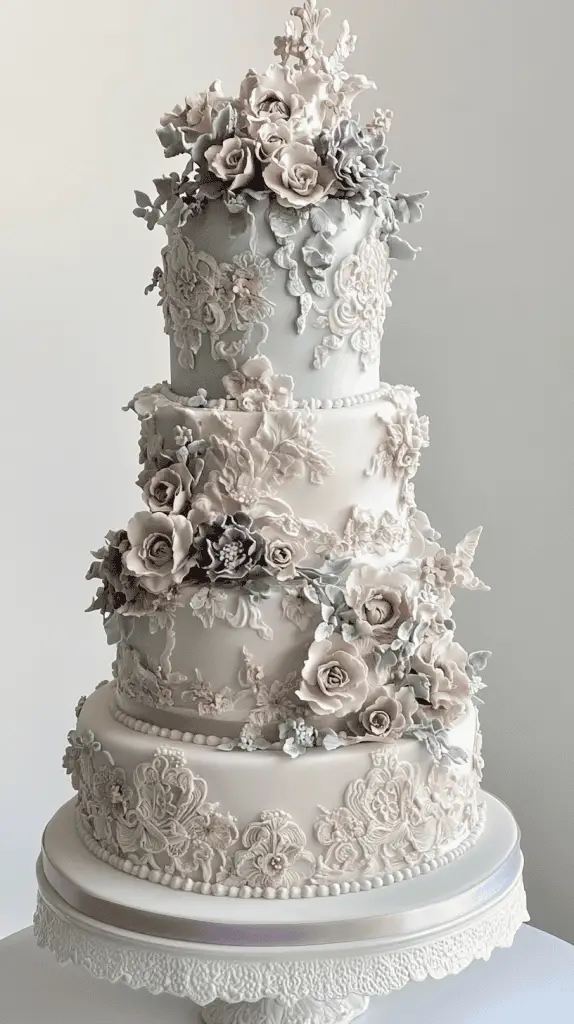
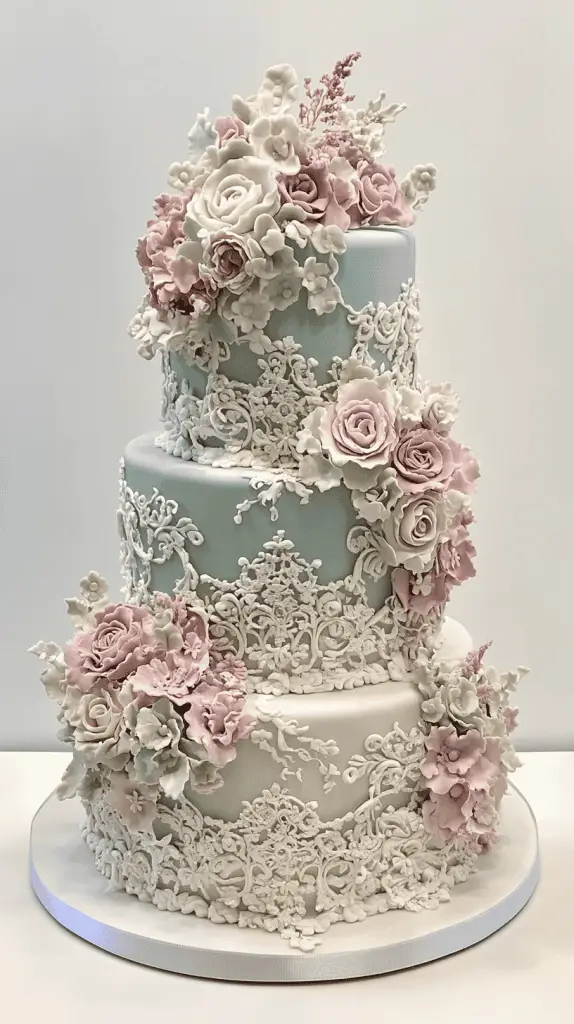
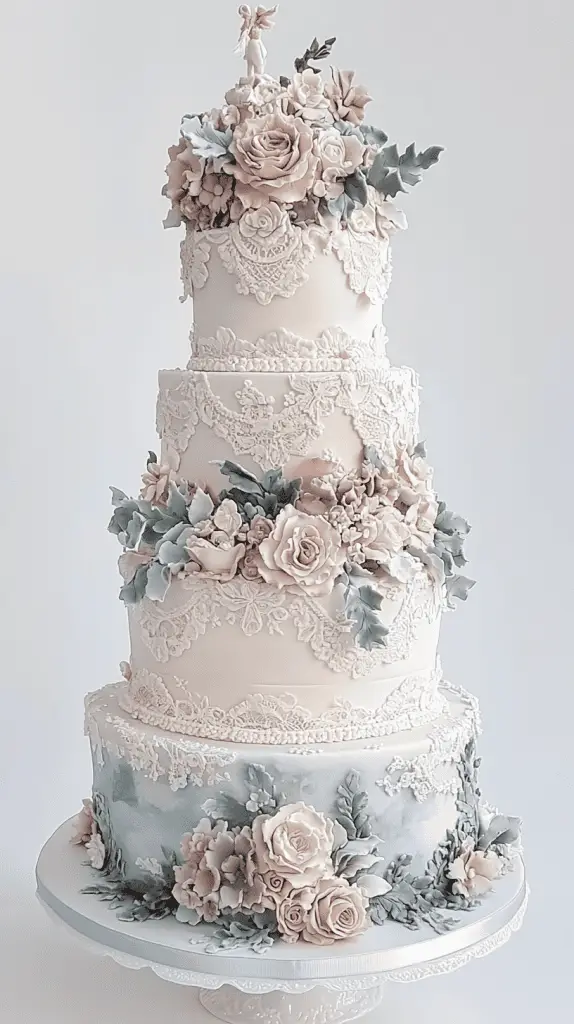
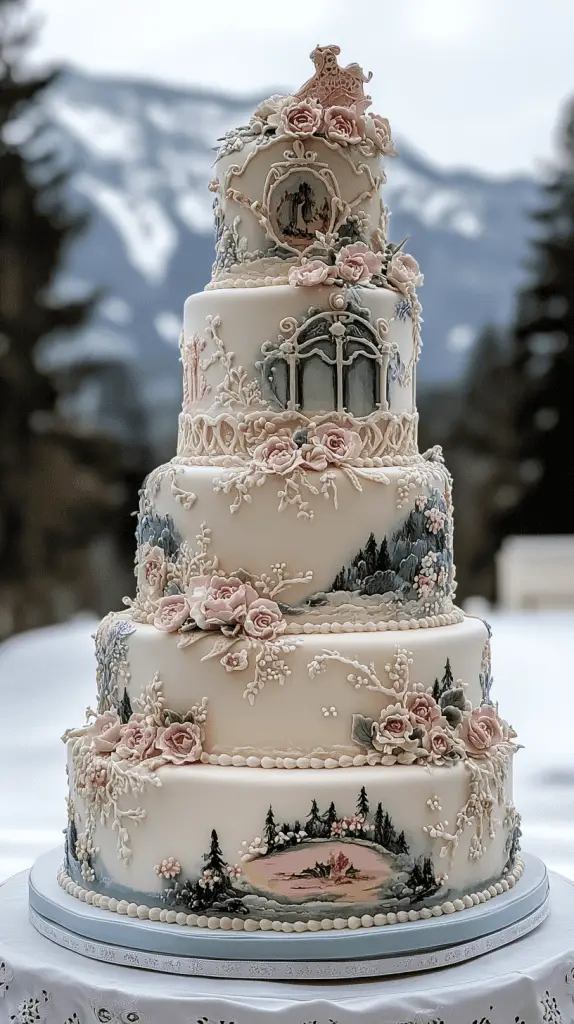
In the Victorian era, elegance and subtlety were expressed through the use of gentle, pastel colors. These hues bring a soft romantic charm to wedding cakes that are reminiscent of a graceful past.
Pastel Hues
Popular pastel colors include soft pinks, pale blues, and mint greens. These colors can be used to create delicate and intricate designs that reflect both romance and tradition.
Cakes often feature layers of these soft tones, adding depth without overwhelming the senses. A combination of pastels can be used for a harmonious palette that is both elegant and complementary.
Designs and Decorations
Incorporating delicate floral motifs and watercolor effects can enhance the Victorian feel. Floral decorations made from edible materials add a touch of nature that is symbolic of the era’s appreciation for natural beauty.
Victorian cakes often use lace patterns and intricately piped details to add a touch of sophistication. These designs complement the pastel hues and help to create a cohesive look.
Materials and Techniques
Buttercream and fondant are common choices for pastel-colored wedding cakes due to their versatility and smooth finish. They allow for the creation of realistic textures and colors.
Using natural dyes can be a way to achieve these pastel shades, ensuring both the aesthetic and the integrity of the flavors are maintained. They reflect the era’s preference for natural ingredients.
Bringing History Forward
Incorporate vintage-inspired cake toppers or antique cake stands to marry the past with the present. Heirloom accents can turn a simple pastel cake into a historical statement, adding a personal touch and deepening the connection to Victorian roots.
8. Gilded Accents: Opulence in Edible Gold and Silver
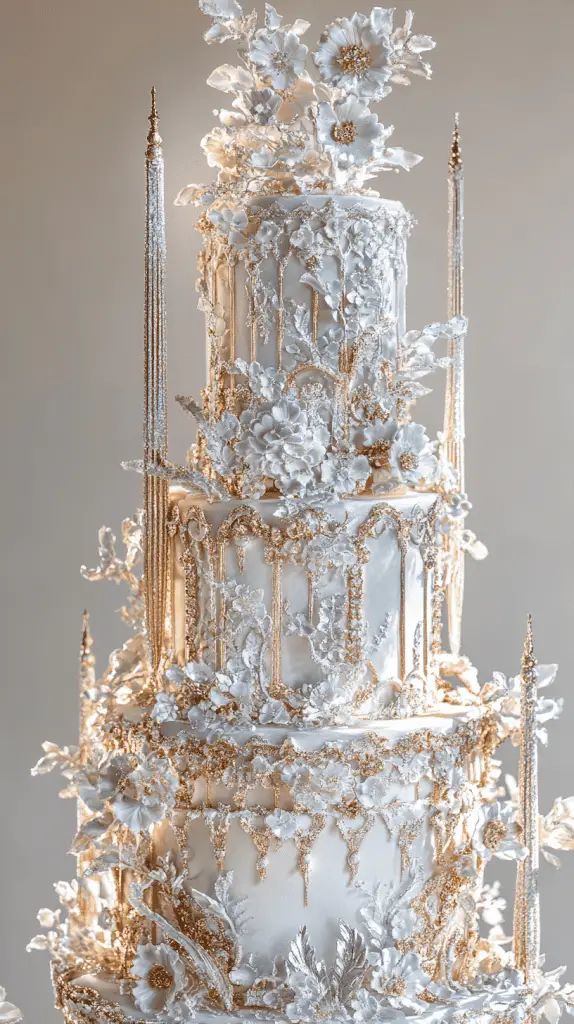
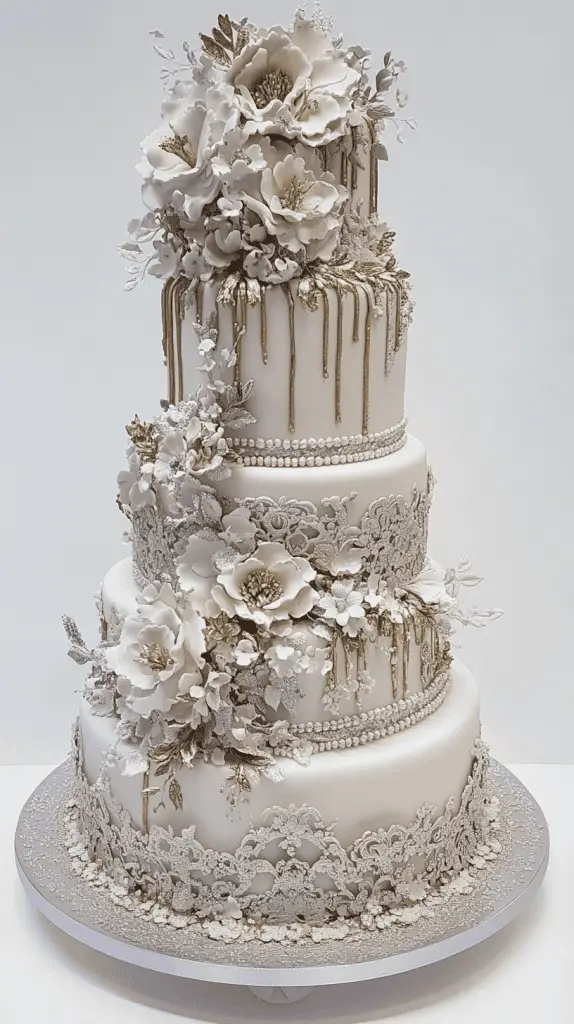
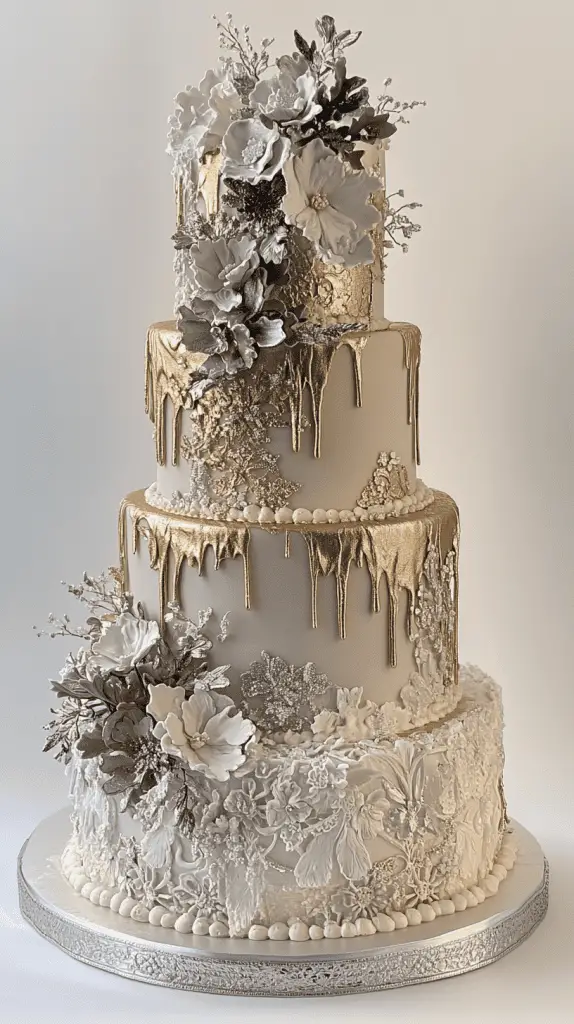
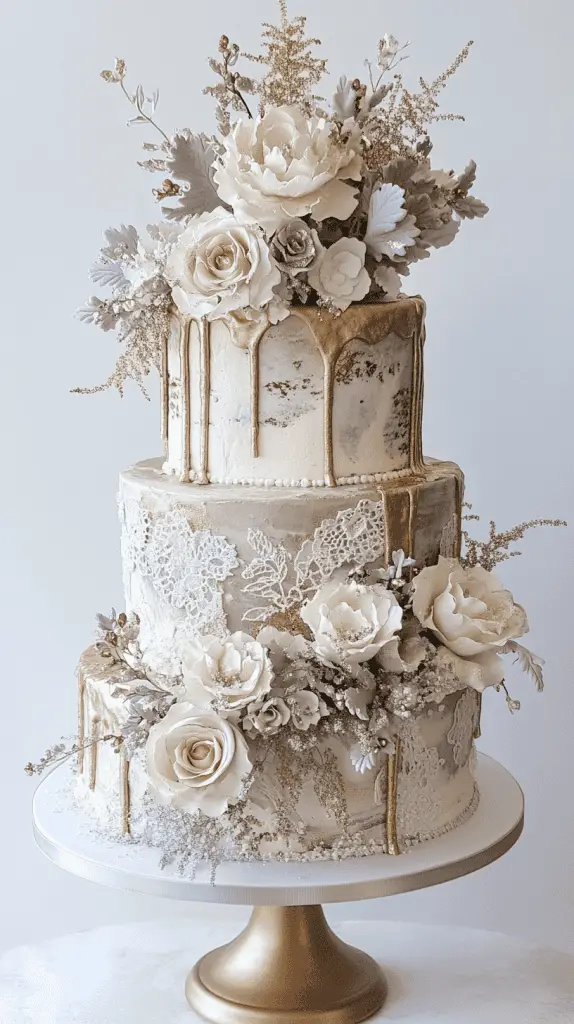
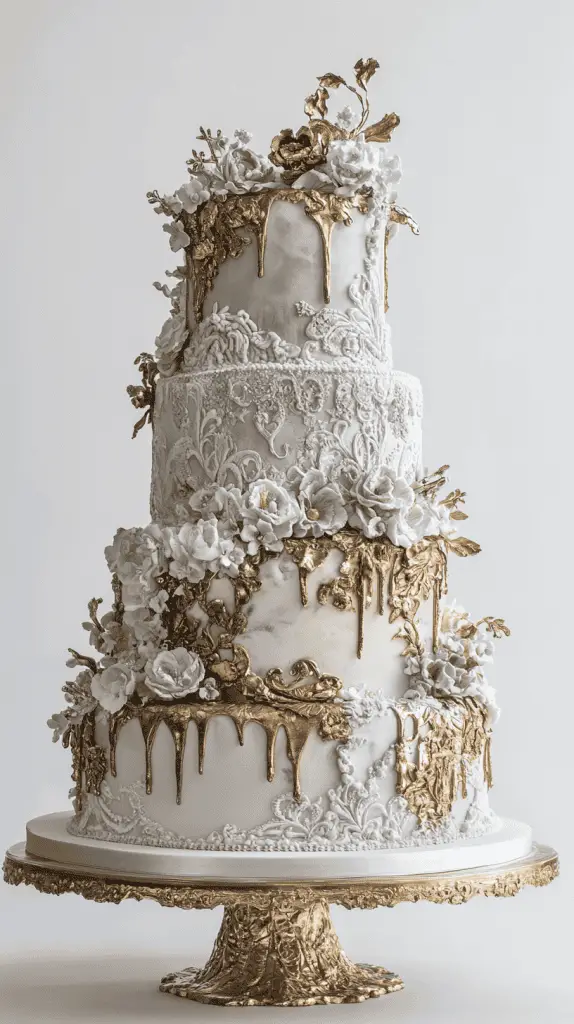
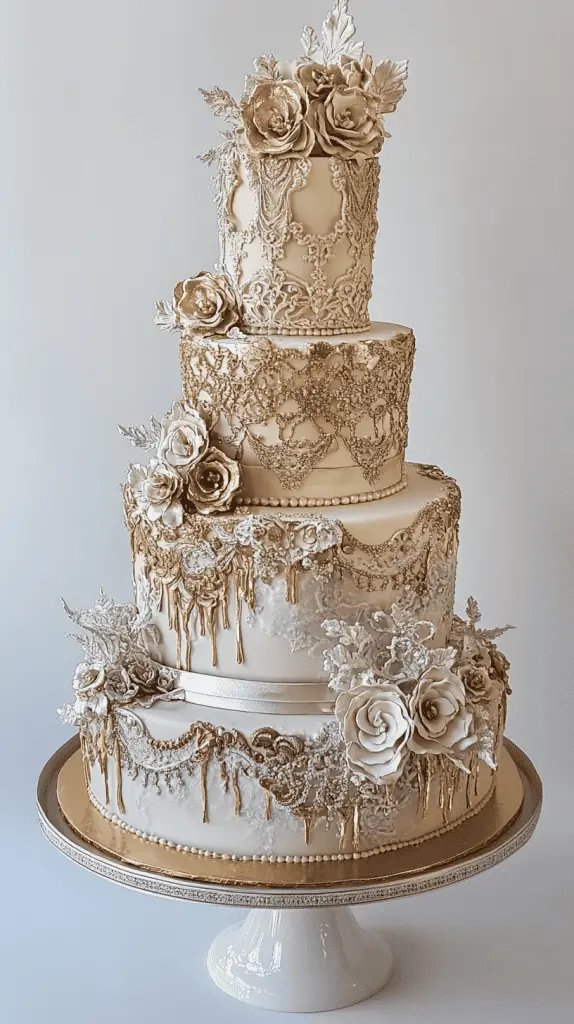
Victorian-inspired wedding cakes featuring gilded accents are a testament to luxury and elegance. Decorators use edible gold and silver to create stunning visual effects. These metallic elements catch the light, evoking a sense of opulence.
Gold and silver can be applied to cakes in various ways. Some decorators use gold leaf or silver dust for a subtle sheen. Others opt for bold accents, such as metallic drips or decorative flourishes.
Integrating these elements requires skill and precision. The metallic accents can be applied to fondant, buttercream, or even directly on the cake surface. This flexibility allows for creative designs.
Pairing gilded elements with traditional Victorian motifs like lace patterns and floral arrangements enhances the cake’s aesthetic. This combination creates a harmonious balance between historical charm and modern extravagance.
Edible gold and silver are non-toxic, ensuring the cake remains safe for consumption. When used in moderation, these materials do not alter the taste of the cake.
Tips for incorporating gilded accents:
- Select a focal point: Apply gold or silver to one area for visual impact.
- Use a light touch: Subtle accents prevent the cake from appearing too gaudy.
- Coordinate with the theme: Match metallics with the wedding’s color scheme for cohesion.
A Victorian wedding cake adorned with gilded accents is more than just a dessert. It’s a statement piece reflecting the grandeur and splendor of a special day.
9. Floral Fantasies: Lavish Blooms and Botanical Intricacies
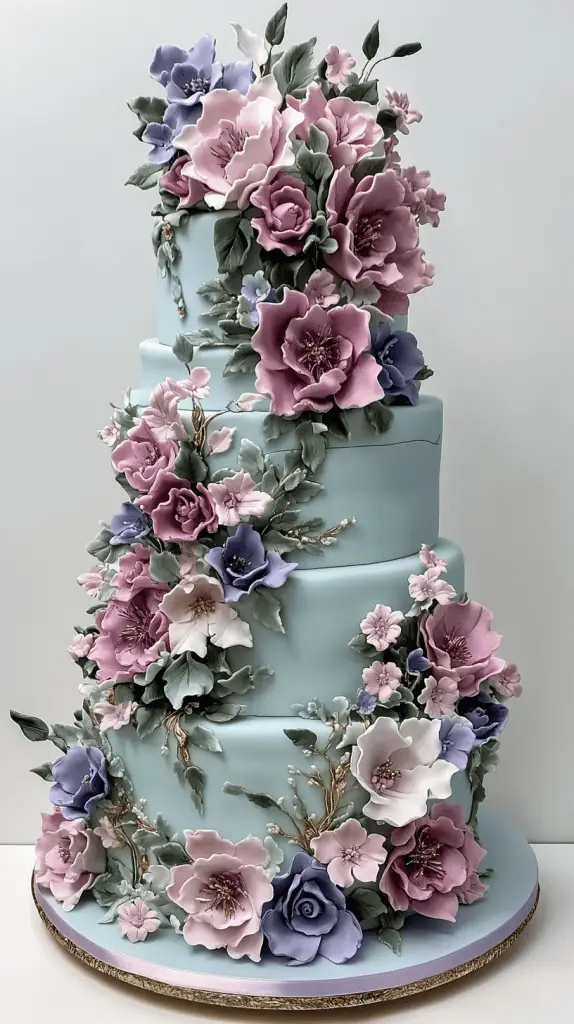
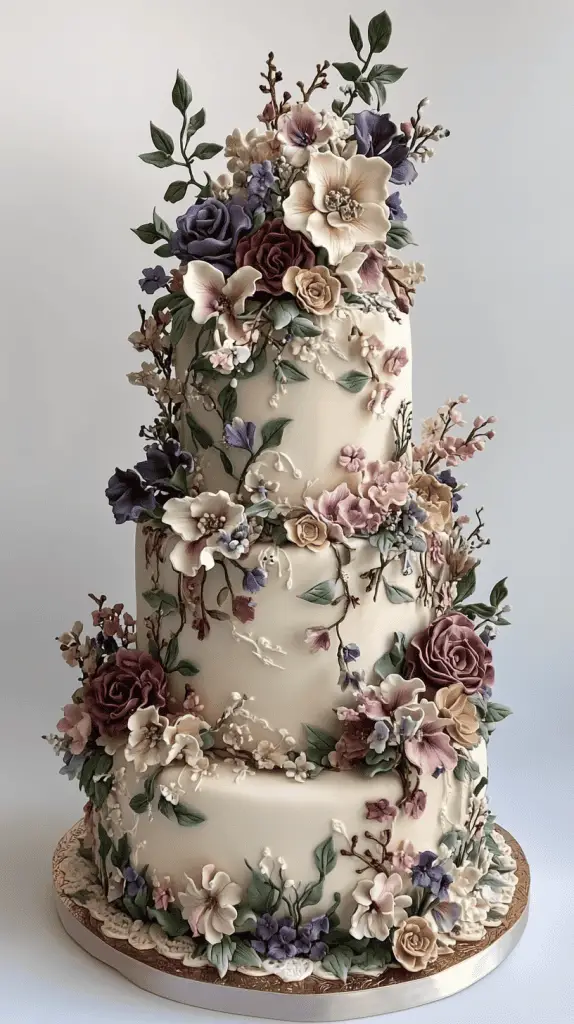
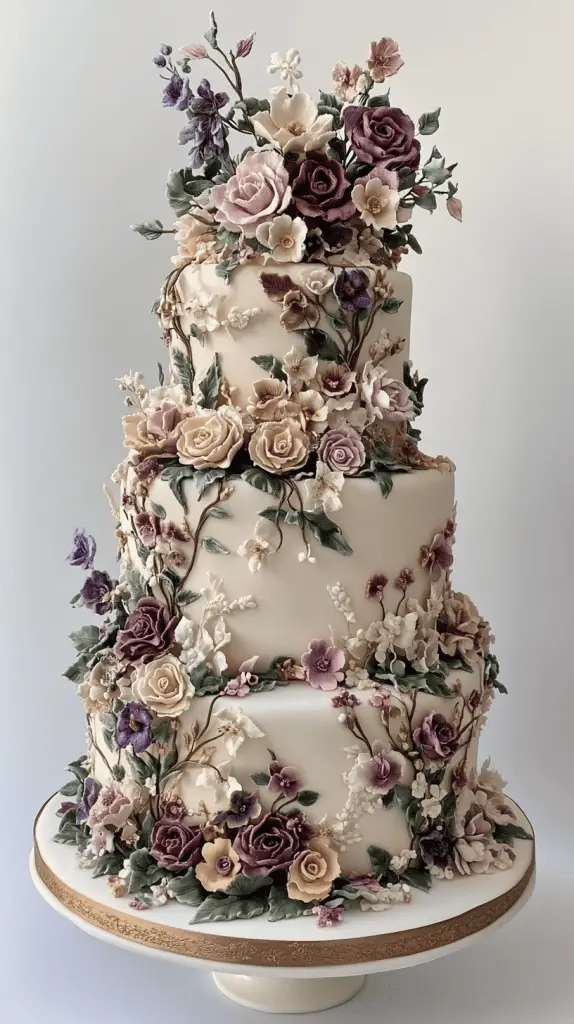
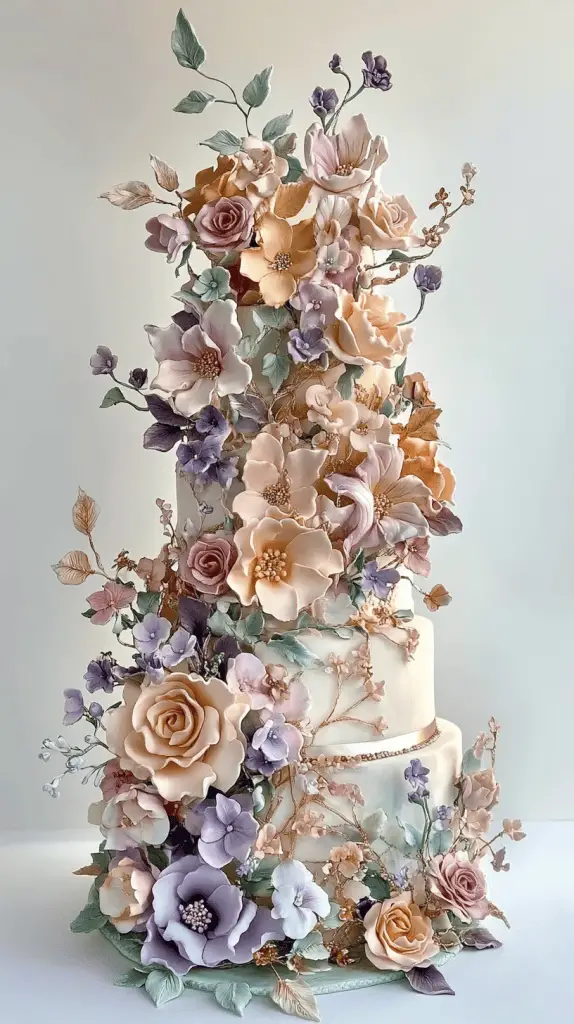
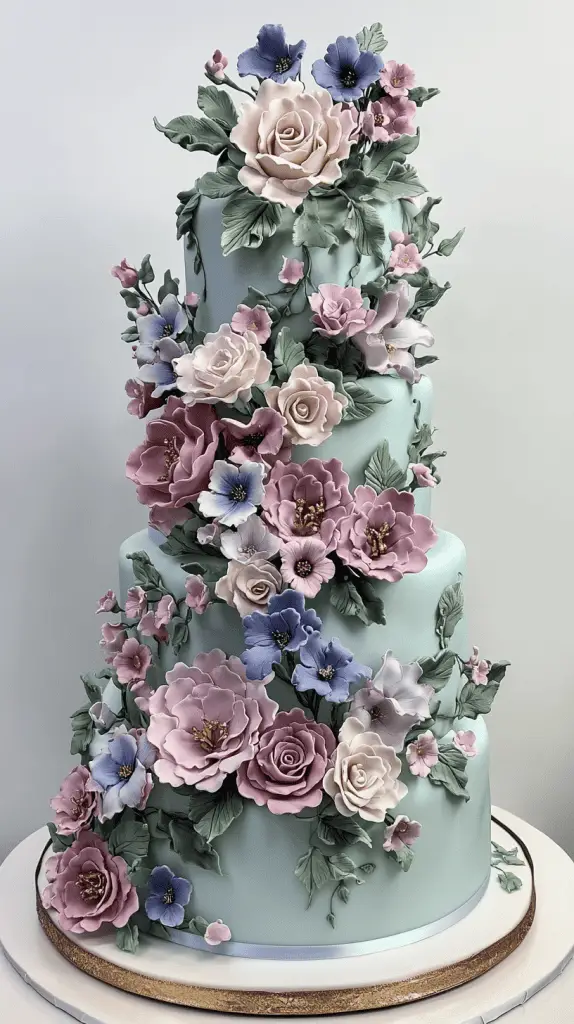
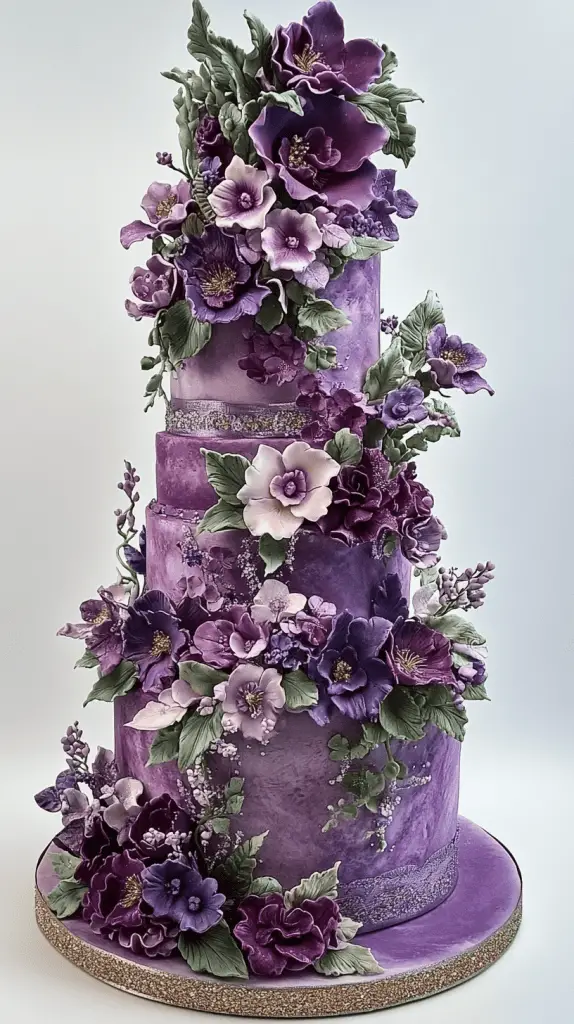
Victorian wedding cakes were often adorned with elaborate floral designs. These cakes featured lavish sugar flowers, including roses, lilies, and violets. Handcrafted with precision, these flowers showcased the baker’s artistry.
Botanical themes extended to cascading vines and intricate leaf patterns. Bakers used piped icing to mimic natural foliage. These details added depth and movement to the cake’s appearance.
For a vibrant touch, edible flowers were sometimes added. Fresh or crystallized petals enhanced the cake’s visual appeal. They also offered a unique taste experience to wedding guests.
Victorian weddings often highlighted nature’s beauty. Floral motifs aligned with this theme, making them a popular choice. Cakes might even feature seasonal blooms to reflect the time of year.
The color palette of these cakes varied widely. Soft pastels and bright hues were common, allowing for personalization. Gold or silver accents were added for a touch of elegance.
This artistic approach to cake design required skill and patience. Bakers invested time in crafting each floral element. Their dedication transformed cakes into breathtaking centerpieces.
Couples who appreciate classic elegance can draw inspiration from these Victorian designs. The floral elements provide timeless beauty suitable for any wedding.
10. Cameo and Brooch Cakes: Nods to Victorian Jewelry Styles
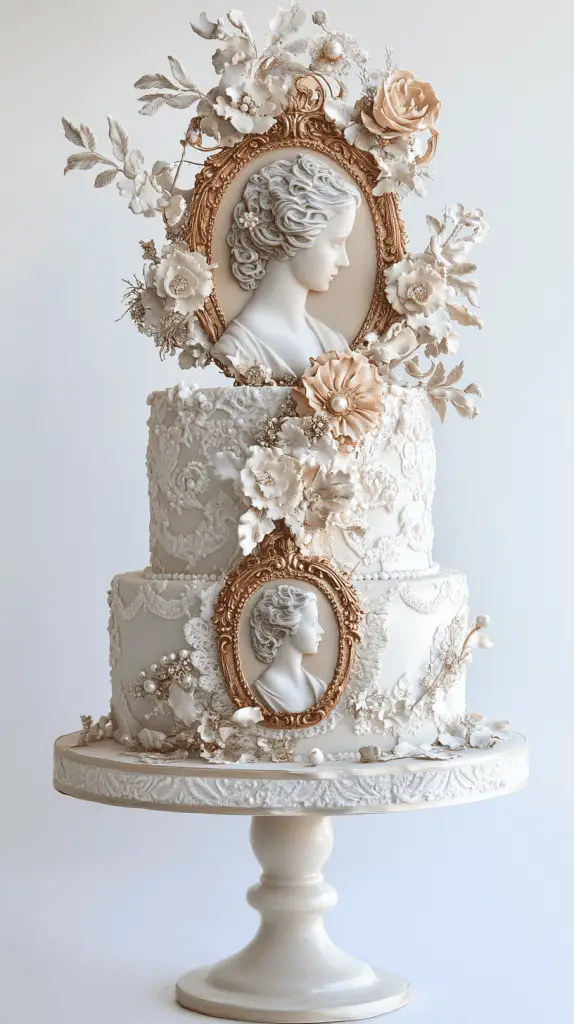
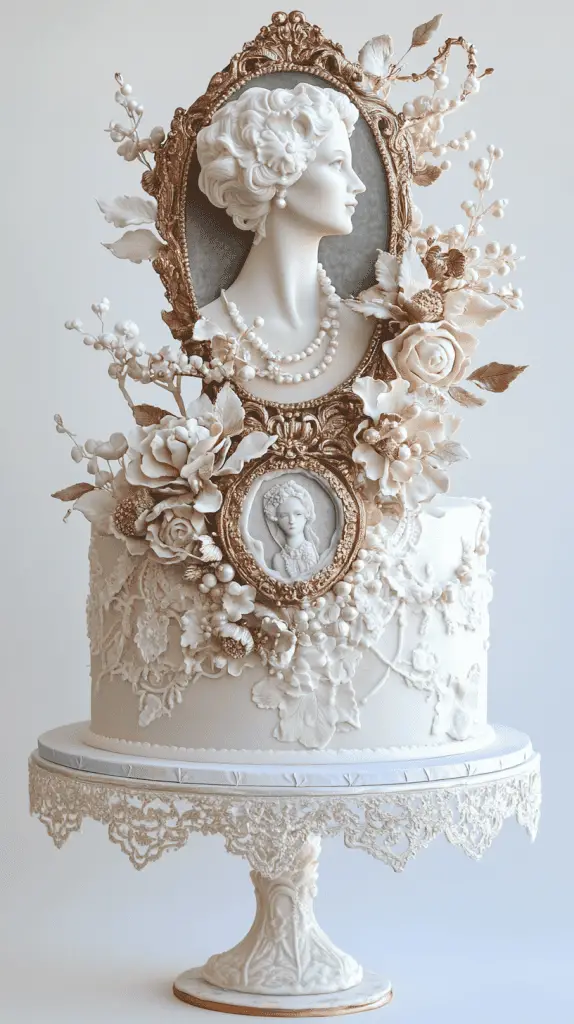
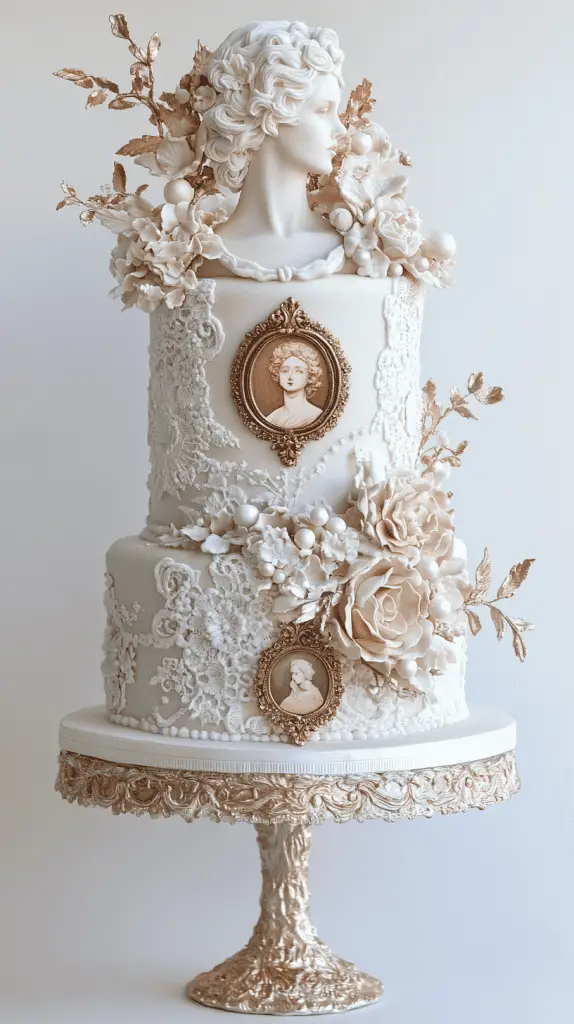
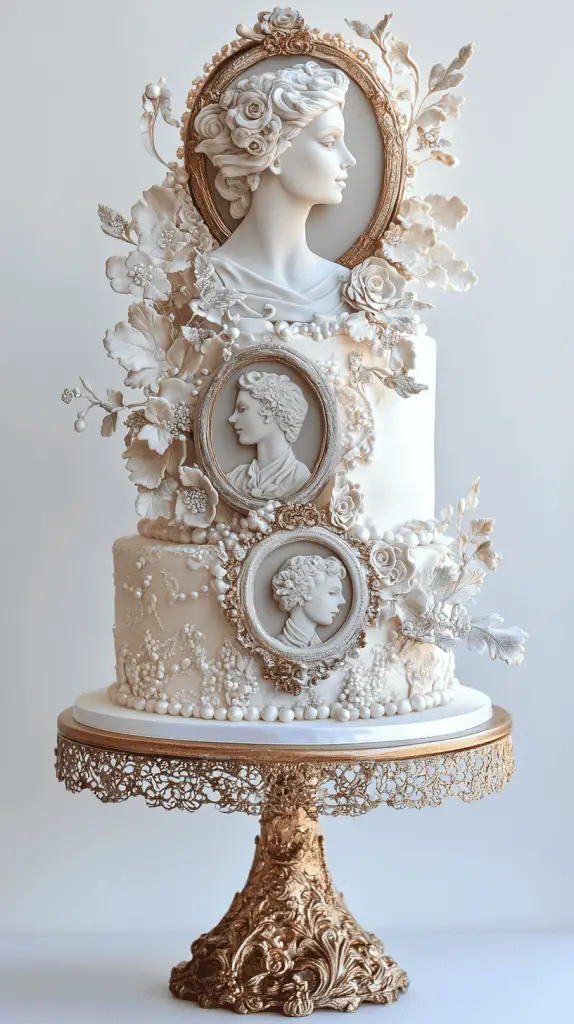
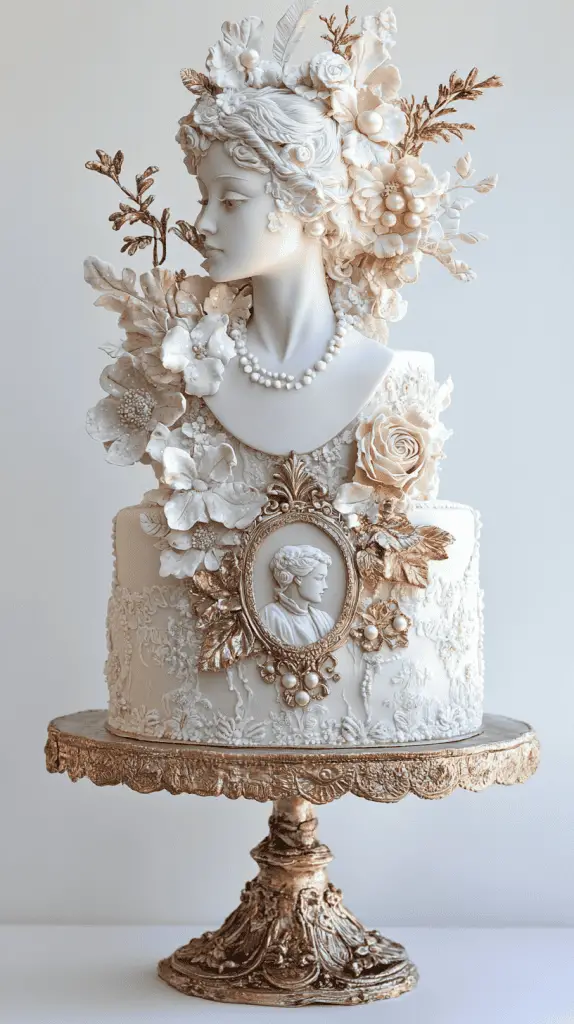
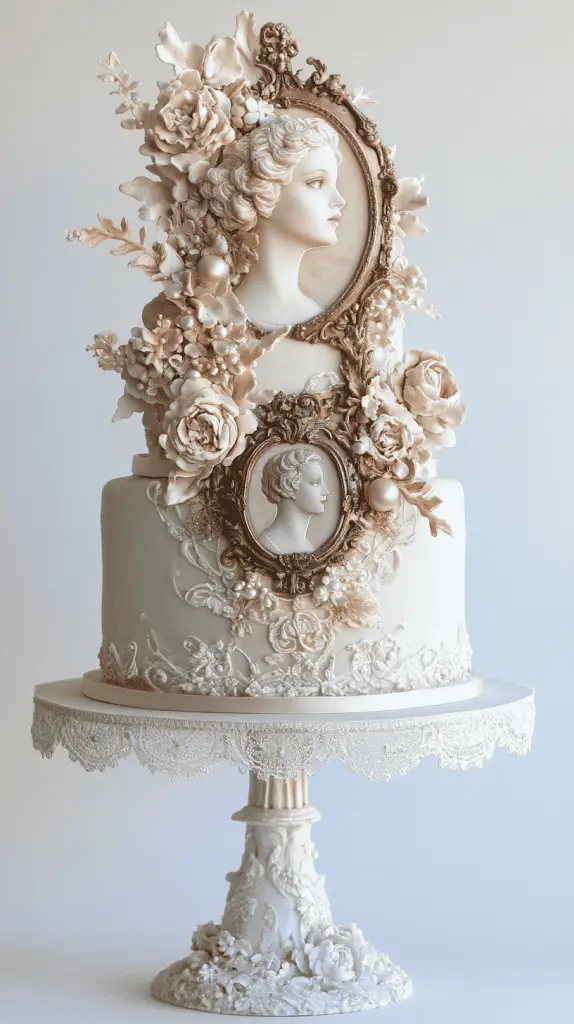
Victorian jewelry styles are often characterized by delicate cameos and intricate brooches. Translating this elegance into wedding cakes combines the charm of Victorian craftsmanship with modern cake artistry. Cameo cakes feature intricate designs of profiles etched in fondant or chocolate, serving as a stunning centerpiece.
Adding edible brooch accents enhances the luxurious feel. These decorations can be crafted from sugar paste or modeling chocolate and adorned with edible pearls and metallic paint. They imbue each cake with an ornate and timeless beauty, offering a refined nod to a bygone era.
These cakes often employ soft, vintage color palettes. Think muted pastels, ivory, and gold. Such colors can capture the era’s elegant tones while providing a romantic touch that’s perfect for weddings. Each cake becomes a unique work of art.
Incorporating lace and floral patterns with edible lace is another popular method. These designs mimic the intricate detail of Victorian jewelry, further enhancing the antique feel. Bakers can add impressive textures and depth to cake layers.
Attention to detail and expert craftsmanship are essential. These cakes are a testament to the ability of skilled bakers to create not just desserts but memorable experiences. Couples looking for unique and historical inspirations often choose these elegant designs for their special day.
11. Ivory and White Perfection: Understated Victorian Sophistication
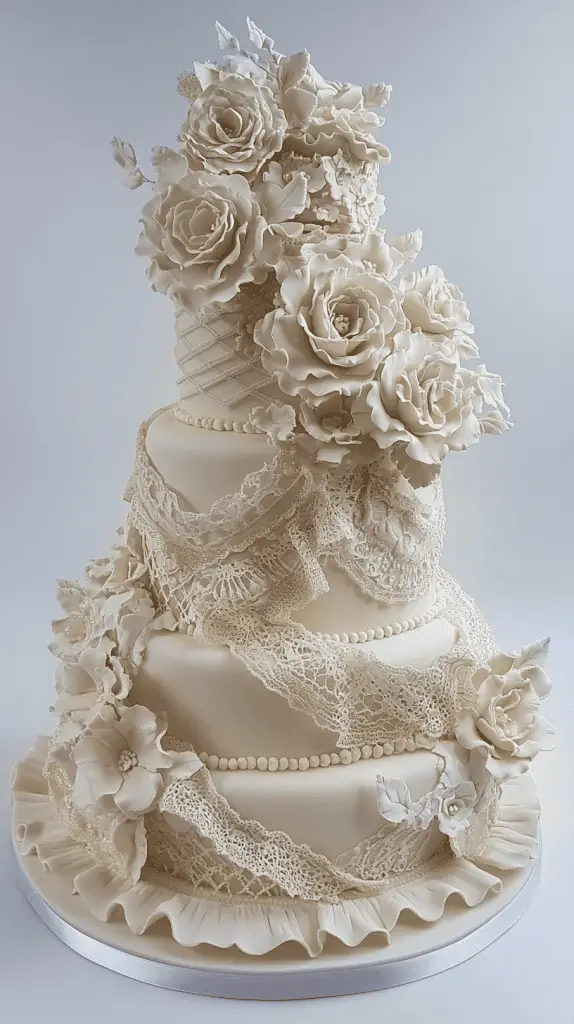
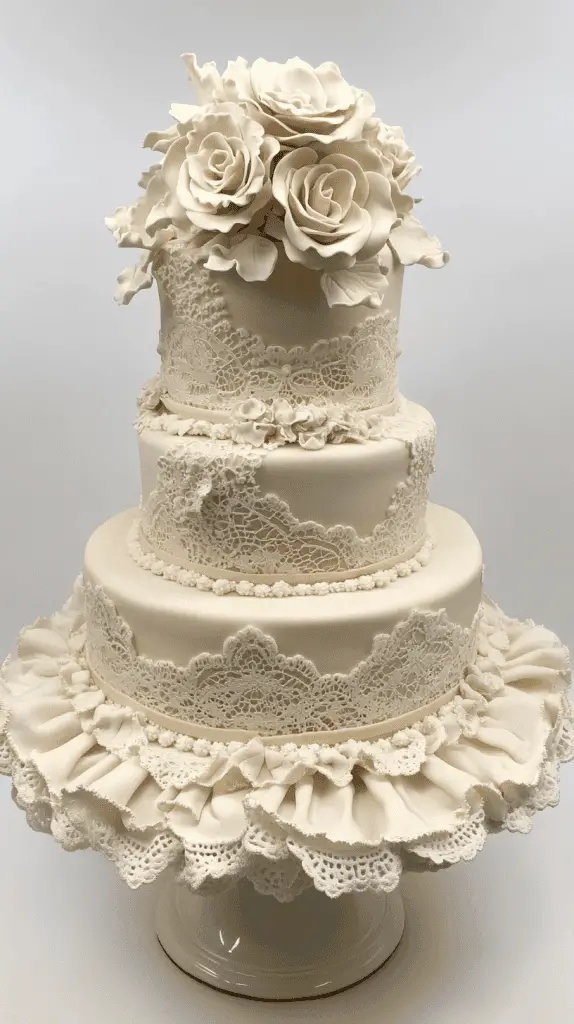
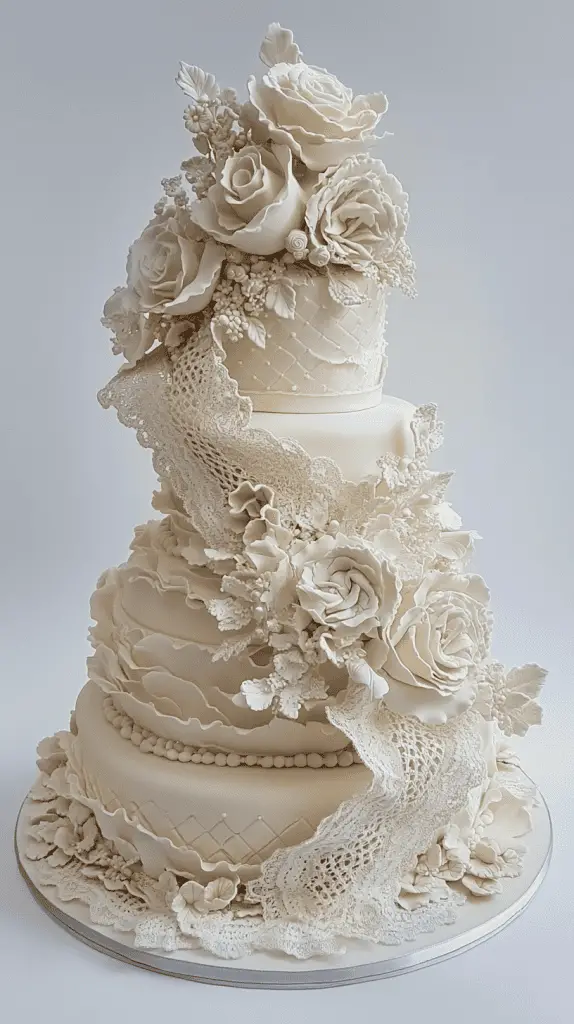
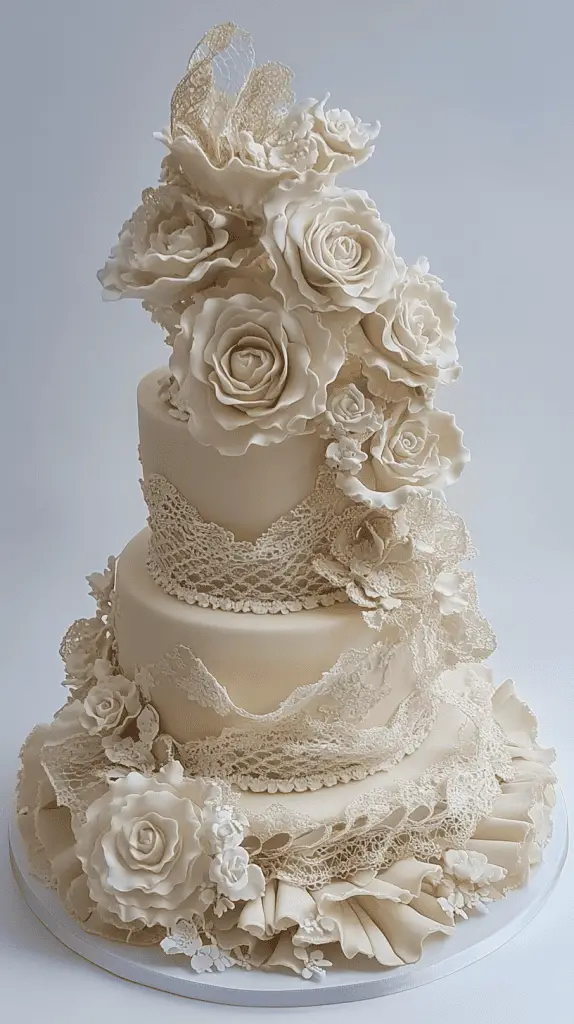
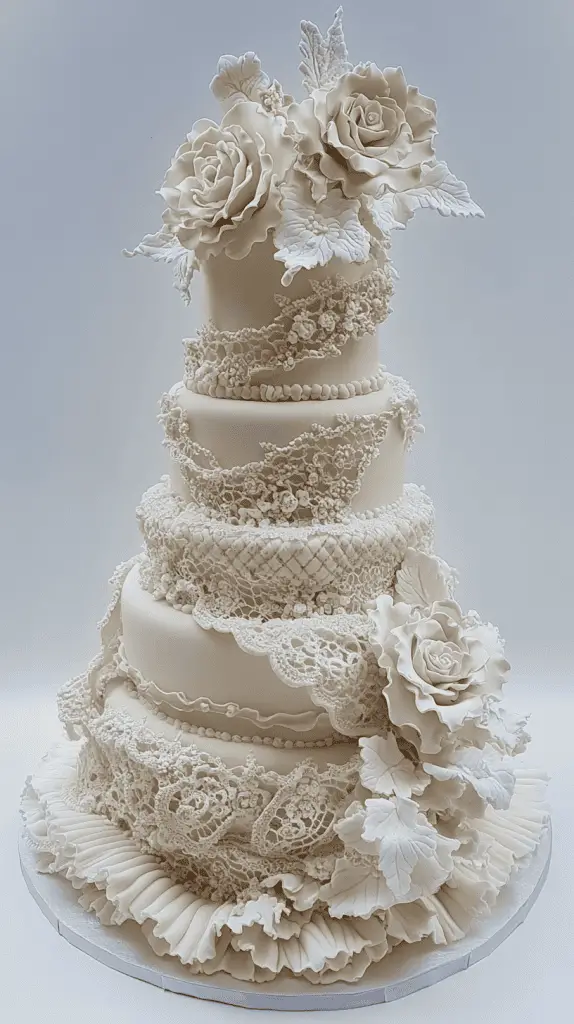
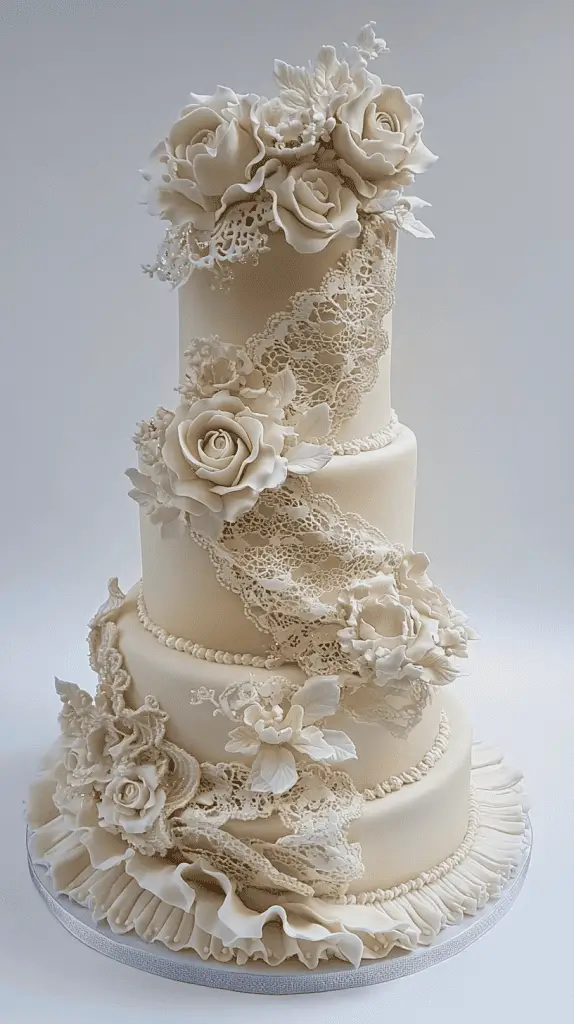
Ivory and white tones embody classic elegance in Victorian wedding cake designs. These muted shades create a foundation for understated sophistication, often enhanced with delicate lace patterns and subtle embellishments. Cakes in these shades maintain a charming and timeless appeal.
A popular choice is an ivory fondant, providing a smooth and refined canvas. This is often accented with white sugar flowers or pearls. These elements, meticulously crafted, offer a visual treat while keeping to the restrained, classical style.
Victorian cakes often feature layers and tiers, showcasing soft ruffles and ornate details. A tiered cake exudes grandeur while still honoring simplicity through its clean lines and subtle motifs.
Textured designs, including lattice or quilt patterns, are typical for adding an intricate touch without overwhelming the cake’s elegance.
Popular Decorations:
- Edible lace
- Sugar roses
- Swiss meringue details
The use of metallic accents in gold or silver enhances the ivory and white palette. These touches, often seen in the form of gilded edges or delicate scrolls, add a hint of luxury.
When selecting flavors, choices like vanilla bean or almond are popular. These flavors complement the cakes’ visual subtlety with equally refined tastes.
Attention to detail is evident in every aspect, from ingredients to decoration, ensuring each cake is a masterpiece of Victorian sophistication.
12. Tiered Grandeur: Multi-Level Statements of Victorian Splendor
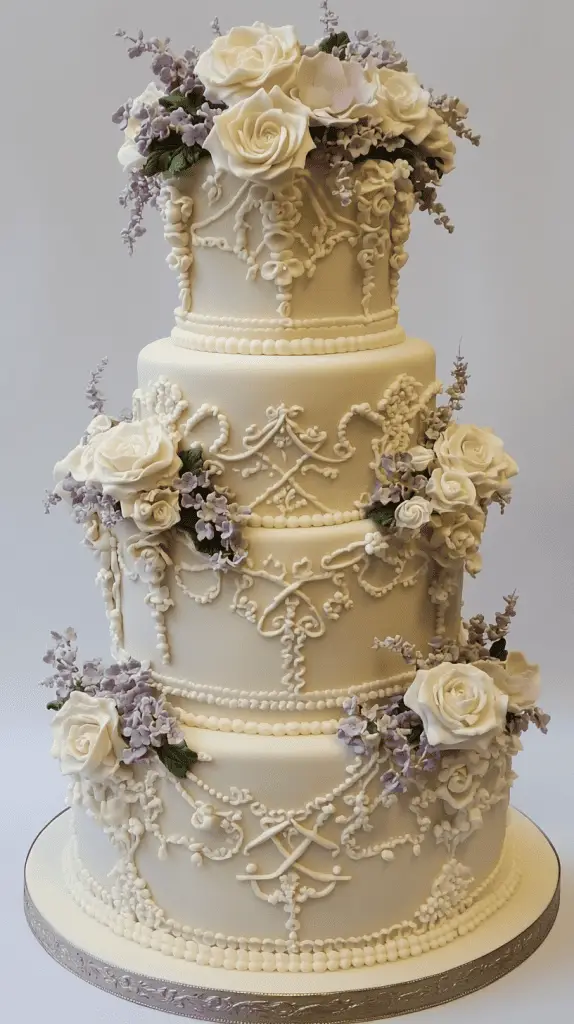
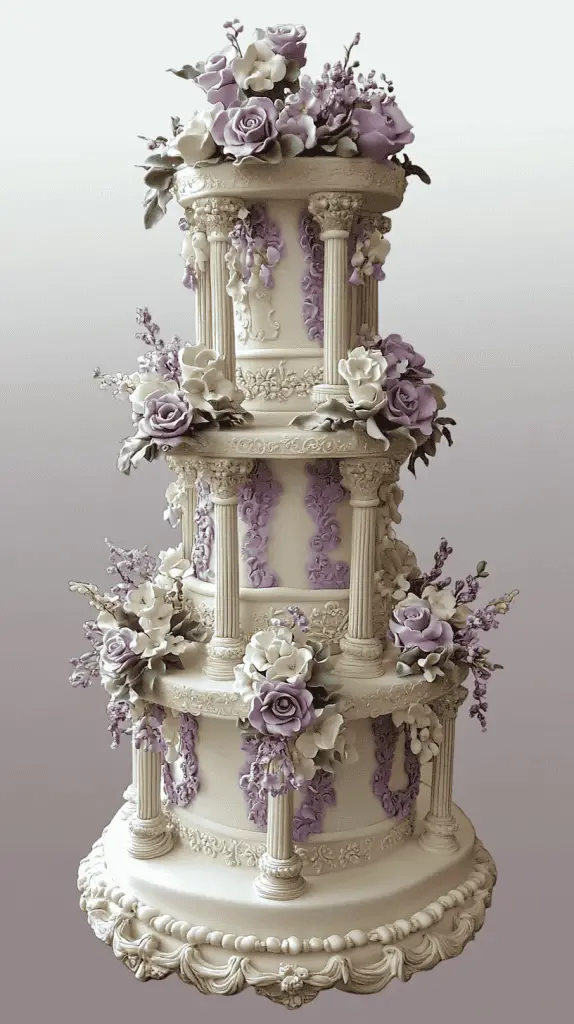
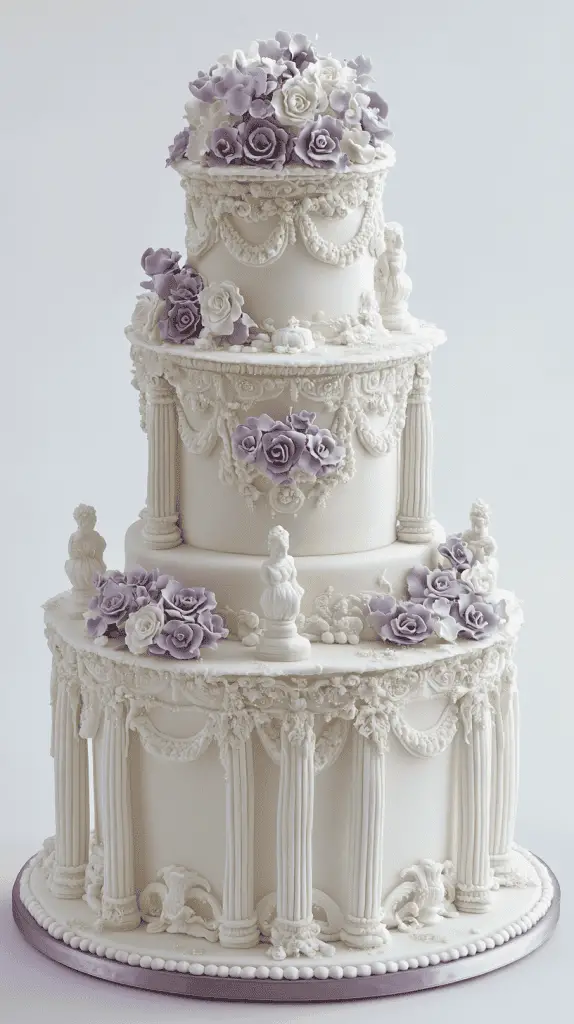
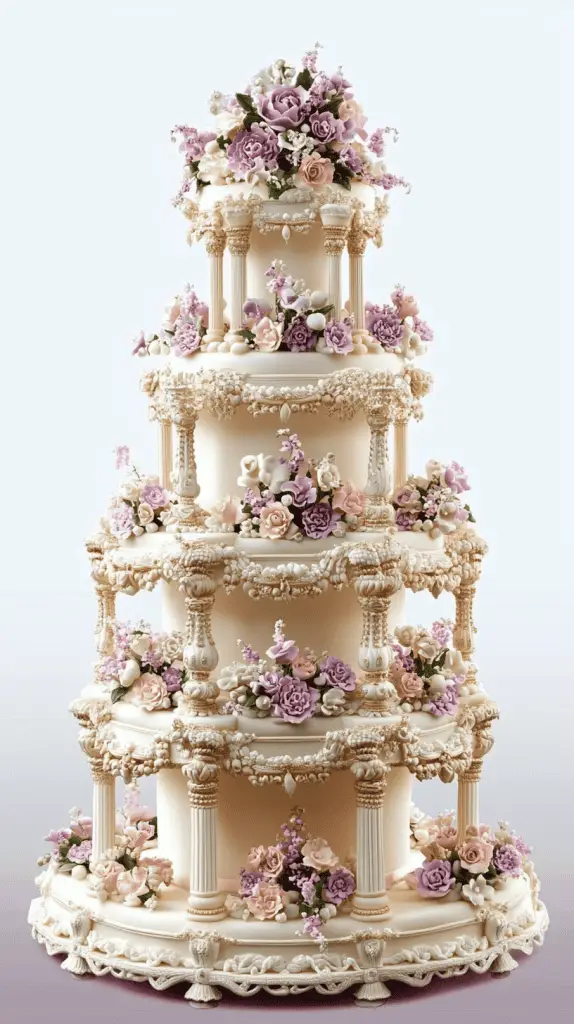
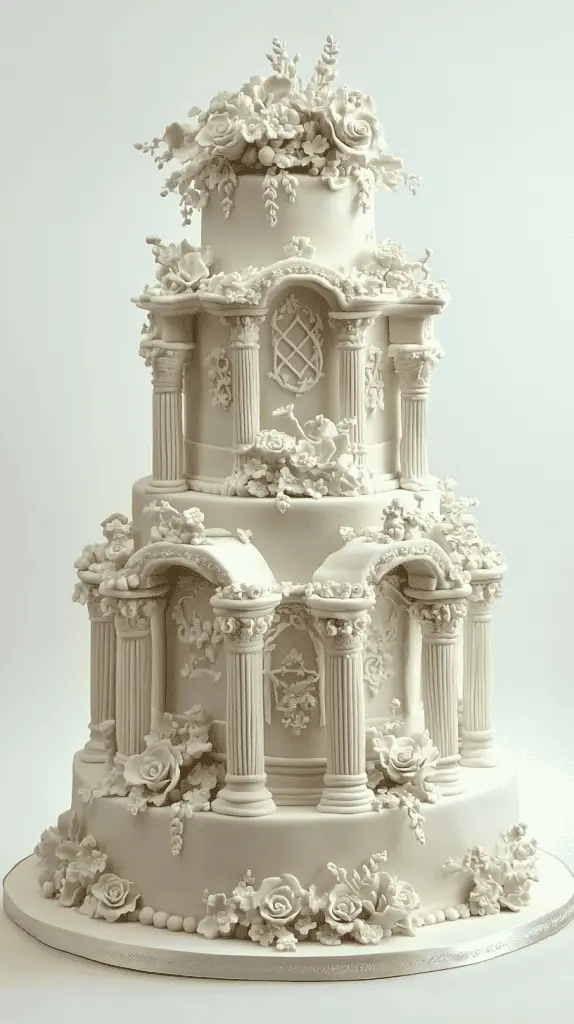
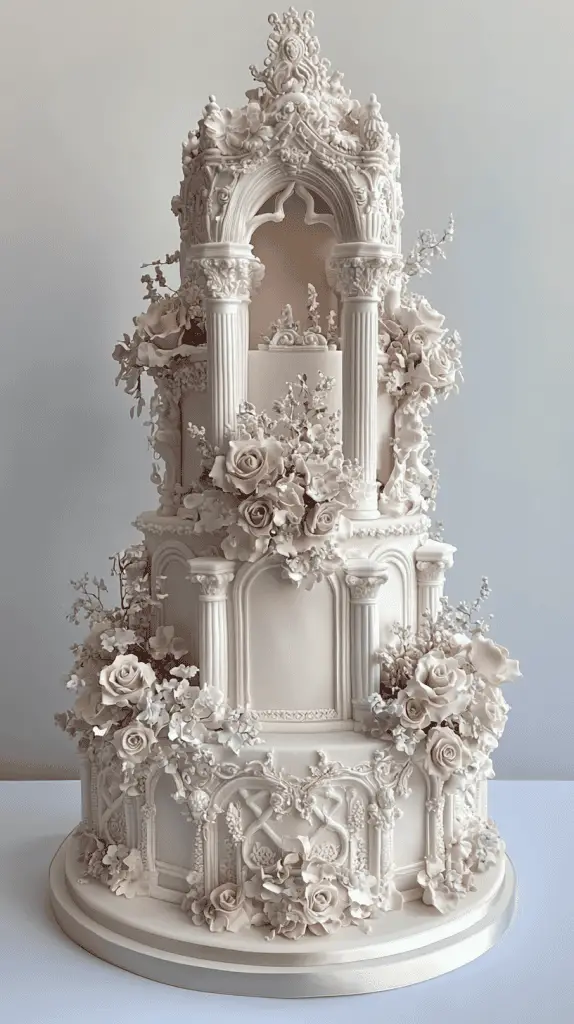
Victorian wedding cakes stand as opulent symbols of extravagance. Among the most striking features are the impressive tiers that speak volumes of grace and style. Each layer adds a touch of elegance, making these cakes true masterpieces.
Traditionally, these cakes feature rich fruit mixtures, often laden with delicious nuts and spices. They are enveloped in smooth, meticulously crafted fondant or royal icing, creating a pristine canvas.
Common features include:
- Pillared Separation: Many cakes employ pillars to separate tiers, allowing more elaborate decoration and the inclusion of floral arrangements.
- Intricate Piping: Delicate details in icing, such as latticework and scrolls, adorn each layer, embodying Victorian artistry.
- Edible Decorations: Incorporating edible flowers, sugar pearls, and even gold leaf elevates the drama and adds to the visual appeal.
The color palette typically includes soft whites and pastels. Subtle hues of lavender, pink, or peach complement the lavish embellishments while maintaining a romantic charm.
Table of Ideas for a Victorian Wedding Cake:
| Tier Count | Decoration Ideas | Color Scheme |
| Two | Floral Piping, Pearls | White, Lavender |
| Three | Rose Sugar Flowers, Gold | Pink, Cream |
| Four | Lace Imprints, Silver Dust | Pastel Peach, Ivory |
These magnificent expressions of taste and skill ensure a memorable visual centerpiece.

